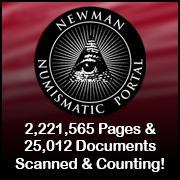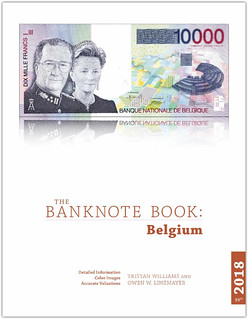
About UsThe Numismatic Bibliomania Society is a non-profit association devoted to the study and enjoyment of numismatic literature. For more information please see our web site at coinbooks.org SubscriptionsThose wishing to become new E-Sylum subscribers (or wishing to Unsubscribe) can go to the following web page link MembershipThere is a membership application available on the web site Membership Application To join, print the application and return it with your check to the address printed on the application. Print/Digital membership is $40 to addresses in the U.S., and $60 elsewhere. A digital-only membership is available for $25. For those without web access, write to: Terry White, Treasurer AsylumFor Asylum mailing address changes and other membership questions, contact Terry at this email address: terrywhite5475@yahoo.com SubmissionsTo submit items for publication in The E-Sylum, write to the Editor at this address: whomren@gmail.com BUY THE BOOK BEFORE THE COINSale Calendar |
- WAYNE'S WORDS: THE E-SYLUM OCTOBER 3, 2018
- LIST OF NBS FOUNDING MEMBERS SOUGHT
- NEW BOOK: UTAH TRADE TOKENS, 2ND ED, SUPPLEMENT #1
- NEW BOOK: THE BANKNOTE BOOK: BELGIUM
- JEAN-BAPTISTE GIARD (1932-2018)
- NEWMAN PORTAL EXCEEDS 25,000 DOCUMENT MARK
- CHEMICAL ANALYSIS OF EARLY U. S. SILVER COINS
- PAN FALL 2018 SHOW VIDEOS PUBLISHED
- NOTES FROM E-SYLUM READERS: SEPTEMBER 30, 2018
- COIN BOARD NEWS FALL 2018
- THE PENNSYLVANIA RAILROAD HEROIC SERVICE MEDAL
- DICK JOHNSON REMEMBERS FRANK KATEN
- VITO VITI (1787-1866)
- HARVEY STACK'S NUMISMATIC FAMILY, PART 27
- FANCY DANCE COIN DESIGNER GARRISON GARROW
- 1776 CONTINENTAL ITEM: FROM COIN TO MEDAL
- ANS ACQUIRES MEDALLIC ART COMPANY ARCHIVES
- BRESSETT RECEIVES BURNETT ANDERSON AWARD
- HOW DIGITAL PHOTOGRAPHY CHANGED NUMISMATICS
- NUMISMATIC NUGGETS: SEPTEMBER 30, 2018
- CAINE COLLECTION OF FEDERAL PROOFS AND ESSAYS
- FEISEL TOKEN SALE CLOSES OCTOBER 27, 2018
- COIN PRODUCTION AND USE IN GOTLAND
- THE SHILLINGS OF ELIZABETH I
- COWRIE SHELL MONEY FOUND IN SHIPWRECK
- COUNTERMARKED 1786 "BABY HEAD" VERMONT COPPER
- LEIPZIG UNIVERSITY RECEIVES BRUNO EYERMANN MEDALS
- MONEY EXHIBIT BY SWEDEN'S CENTRAL BANK
- WILL SMART BANKNOTES BE THE CASH OF THE FUTURE?
- JOHN LENNON WAS A PHILATELIST
- LOOSE CHANGE: SEPTEMBER 30, 2018
Click here to access the complete archive
To comment or submit articles, reply to whomren@gmail.com
Content presented in The E-Sylum is not necessarily researched or independently fact-checked, and views expressed do not necessarily represent those of the Numismatic Bibliomania Society.
WAYNE'S WORDS: THE E-SYLUM OCTOBER 3, 2018
 This week we open with a question for NBS
members, two new books, the loss of a prominent numismatist, and updates from the Newman Numismatic Portal.
This week we open with a question for NBS
members, two new books, the loss of a prominent numismatist, and updates from the Newman Numismatic Portal.
Other topics this week include chemical analysis of early U.S. silver coins, the Pennsylvania Railroad Heroic Service medal, numismatic literature dealer Frank Katen, coin designer Garrison Garrow, and the Medallic Art Company.
To learn more about Jean-Baptiste Giard, the Mint and Coinage Act of April 2, 1792, fake oval Indian Peace medals, the the Fancy Dance coin, the 1978 Zodiac Calendar medal, Bruno Eyermann medals, the Good For Entrance to Paradise token, shillings of Elizabeth I, and the smart banknotes of the future, read on. Have a great week, everyone!
Wayne Homren
Editor, The E-Sylum
LIST OF NBS FOUNDING MEMBERS SOUGHT
Pete Smith has a question for our early members. -Editor
List of NBS Founding Members Sought
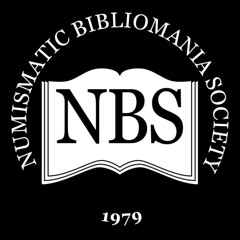 The Numismatic Bibliomania Society traces its
origins back to a dinner held during the 1979 ANA convention in St. Louis. It was reported that about a dozen people attended. I have not found a published list of their
names.
The Numismatic Bibliomania Society traces its
origins back to a dinner held during the 1979 ANA convention in St. Louis. It was reported that about a dozen people attended. I have not found a published list of their
names.
With the 40th anniversary approaching, I would like to better document the event. Does anyone have a published list of the names? Does anyone who attended remember who was there? Any help will be appreciated.
I came on the NBS scene in 1980, so I missed this landmark event. Who can help? Let me know and I'll forward your information to Pete. Thanks! -Editor
NEW BOOK: UTAH TRADE TOKENS, 2ND ED, SUPPLEMENT #1
A September 29, 2018 Numismatic News article by Dave Harper alerted me to a new edition of Bob Campbell's book on Utah Trade Tokens. Here's the announcement. Thanks, Bob! -Editor
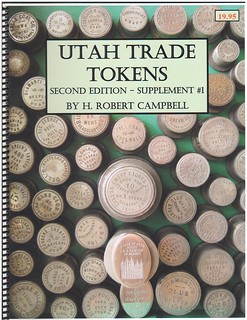 H. Robert
Campbell, past president of the American Numismatic Association, is announcing an update to his award winning 2013 second edition catalog on Utah Trade Tokens. It’s appropriately
called Utah Trade Tokens Second Edition – Supplement #1 and it contains 80 pages of vital information for collectors of mostly trade tokens that were issued in Utah
territory and after it became a state in 1896.
H. Robert
Campbell, past president of the American Numismatic Association, is announcing an update to his award winning 2013 second edition catalog on Utah Trade Tokens. It’s appropriately
called Utah Trade Tokens Second Edition – Supplement #1 and it contains 80 pages of vital information for collectors of mostly trade tokens that were issued in Utah
territory and after it became a state in 1896.
This particular booklet has information of all new trade tokens since the release of the main catalog in 2013, plus what Mr. Campbell considers the greatest threat currently to the Utah trade token market in modern times. Numerous pictures depict that threat which is the original token dies that have entered into to marketplace. This catalog make the first attempt of tracking these dies entering into collectors hands which he hopes will avert people making replica examples that could infiltrate would-be collectors and cause rarities and prices to decrease and hurt the overall market. It puts all people on alert status and makes this information available to everyone to “watch out” for these possible spurious examples.
Also he has cataloged and evaluated the potential prices from token dies which no tokens are known at this present time. There potential prices if they were to show up are now calculated and are logically evaluated. A highlighted story of the newly found Occidental Saloon trade token from Oasis Utah and a “market analysis” round up valuable information in this supplement.
It's cost is $19.95 postage paid. The main second edition on Utah Trade Token (480 pages) is also still available at a large reduced price. Contact him personally at All About Coins, 1123 East 2100 South, Salt Lake City, UT 84106 PH: 801-467- 8636. Make checks payable to All About Coins, or Credit Cards over the phone.
For more information, or to order, see:
http://www.allaboutcoins.com/contact-us.html
To read the complete Numismatic News article, see:
Utah token catalog gets an update
(http://www.numismaticnews.net/buzz/utah-token-catalog-gets-an-update)
NEW BOOK: THE BANKNOTE BOOK: BELGIUM
Buon giorno! I'm pleased to announce the Belgium chapter is now available for individual sale at US$9.99, and as a free download to subscribers.
Belgium(Europe) This 57-page catalog covers notes issued by the Société Générale (General Company) from 1822 to 1915, the Banque de Belgique (Bank of Belgium) in 1835, the Banque Liégeoise et Caisse d'Épargnes (Liége Bank and Savings) in 1835, the Banque de Flandre (Bank of Flanders) in 1841, the Banque Nationale de Belgique (National Bank of Belgium) from 1851 to 1998, the Banque d'Emission à Bruxelles (Bank of Issue in Brussels) in 1941, and the Royaume de Belgique Trésorerie (Kingdom of Belgium Treasury) from 1948 to 1966. Published 28.09.2018.
For more information, or to order, see:
http://banknotebook.contentshelf.com/shop

Hadrien Rambach submitted this annoucement of the passing of Jean-Baptiste Giard, former curator at the Bibliothèque Nationale. Thank you. -Editor
 It is with extreme sadness that I heard
the announcement of the passing of Jean-Baptiste André Marie Joseph Giard, former curator of Roman coins in the Cabinet des Médailles of the Bibliothèque nationale de France
(1961-1997), where he acted as conservateur en chef from 1992. Like many other visitors, I had the chance to benefit from his welcome at the coin cabinet, from his
scientific advice, and from passionate and entertaining discussions with him.
It is with extreme sadness that I heard
the announcement of the passing of Jean-Baptiste André Marie Joseph Giard, former curator of Roman coins in the Cabinet des Médailles of the Bibliothèque nationale de France
(1961-1997), where he acted as conservateur en chef from 1992. Like many other visitors, I had the chance to benefit from his welcome at the coin cabinet, from his
scientific advice, and from passionate and entertaining discussions with him.
Jean-Baptiste Giard was a member of the board of the International Numismatic Commission, from the Bern meeting of 1979 until the London meeting of 1986. Most museum curators knew him, not only because he had received them in Paris, but also because he travelled extensively (even in the former Soviet Union) in order to make the casts that allowed him to later write his books on the Paris coin collection and on the coinage of the Lyon mint. He adopted a comprehensive approach, intending to build a corpus including die-studies, and his work is distinguished by its precision and depth, the result of setting a high intellectual standard – for himself as he did for others.
He started teaching Roman and Mediaeval numismatics at the École du Louvre in the late 1960s, then at the École Normale Supérieure (ENS) in the 1970s, and then from 1985 until c.2000 at the École des hautes études en sciences sociales (EHESS). He had also been Assistant at the Institute for Advanced Studies in Princeton (1974-1977), where he befriended Andreas Alföldi († 1981) and André Weil († 1998).
The last of 18 children, Giard was born in 1932 to an educated catholic family from northern France. His father René, a chartiste like his son would later be, came from a long line of bookdealers in Valenciennes who had been in business since the 1750s). His happy childhood – educated at the Collège Sainte Odile in Lille – was interrupted by the Second World War: not long after the death of his father in March 1940, he had to flee in May-June 1940 first towards the Poitou and then to Normandy where he remained until December 1941. During this exodus he was separated from his mother– and two of his brothers died in the war.
He later went back to Lille where he studied at the Saint-Joseph Jesuit school. After obtaining his baccalauréat in 1952, he moved to Paris to study at “Henri IV” and then graduated as archivist-palaeographer from the École nationale des Chartes in 1960. The following year, he started working as a librarian at the Bibliothèque nationale de France, and he graduated in 1964 from the École pratique des hautes études (4th section). At the invitation of the director Henri Seyrig († 1973), whom he admired greatly, he became a resident of the Institut français d’archéologie in Beyrouth (1966-1967).
He had discovered numismatics during his studies, and his 1960 thesis was dedicated to La Monnaie de Saint-Quentin au temps de Charles VI et de Charles VII, 1385-vers 1447. He continued to do some research on French medieval coinage, but his interests quickly turned towards Roman numismatics, in which he soon became a leading specialist. His most-used works are his books on the coinage of Lugdunum (Lyon), on which he published two volumes: a first one in 1983 on the period 43 bc – ad 41, and a second in 2000 on the periods ad 41-78 and ad 196-197, completing the series started by his friend Pierre Bastien († 2006); and the series Catalogue des monnaies de l’Empire romain (collection du Cabinet des médailles de la Bibliothèque nationale), which he initiated with a volume on the coins of Augustus (first published in 1976, with new corrected editions in 1988 and 2001), and then continued with a volume on the coins of Tiberius to Nero (1988), and one that covered the collections down to the reign of Nerva (1998).
His vast interests, and his philological abilities, led him to deal with non-numismatic subjects: his translation of and comments on Lorenzo Valla’s denunciation of the forged “Donation of Constantine” was published in 1993 with an introduction by Carlo Ginzburg.
Jean-Baptiste Giard did not only start and direct the publication of an important Italian hoard, the Rispostiglio della Venèra (vol. II/2 in 1987, vol. I and vol. II/1 in 1995, vol. IV in 2000 and vol. III.1 in 2009), he also created the series Trésors Monétaires – the first 12 volumes of which he edited (1979-1992), not long after the start of the British series of Coin Hoards (published 1975 onwards). This dedication to the publication of coin finds and hoards is significant, and is reflected in his own publications. Probably as a consequence of the study of these French finds, Giard published several articles on the Roman currency of Gaul.
In 1989, he published Médailles et antiques I – Trésors monétaires – supplément 2, in which he aimed at studying the history of numismatics, at enlarging the fields of research by linking – for example – the development of the art of the medal in the Renaissance with the growing interest given to ancient ‘medals’. In it, he included an article on Un camée du Roi René, though he published otherwise little on glyptics: only an article on Une intaille d’Auguste (1975) and a book on Le Grand camée de France (1998), but he was interested in the field because of the obvious similarities in subjects and type of depictions. Like Marie-Louise Vollenweider († 2008), he understood well the connections between engraving coins and engraving gems, and the advantage that numismatists have in identifying portraits.
Indeed, portraiture was a real passion of his, and in 1980 he published Le portrait d’autrefois. This was followed by numerous articles, and several entries for Stephen Scher’s exhibition catalogue The Currency of Fame. Portrait Medals of the Renaissance (1994). He also leaves an unpublished manuscript devoted to portraiture (L’Illusion du Portrait).
His articles on portraiture show clearly a transition from the Roman period, his main interest, to the Renaissance, and this was what led to him becoming an authority on the history of numismatics. In addition to those books and articles, Giard published a great number of book reviews: at least 91 of them, mostly in the French Revue numismatique 1962-1997 (he acted as the Revue’s secretary from 1962 until 1972 and then as one of its directors from 1974 until 1996), but also in the Bibliothèque de l’école des chartes (1964-1973), and in the Revue des Études Anciennes (1983).
His reviews show his deep understanding of many subjects, as well as his mastery of many languages such as Italian, Spanish, English and notably German, which he had studied in his teenage years despite the trauma of the war. This dedication to reviewing books is an example of his constant desire to remain up to date with current research, and to exchange points-of-view with colleagues.
In addition to his historical interests, Jean-Baptiste Giard was also dedicated, notably in later years, to political and social issues. Few people were aware of it, but his life was devoted to helping others: for many he was a stable support, providing help to those experiencing difficulties – financial or of any sort –, sharing his intelligence and thought-provoking criticism to students like myself. Without judging or ever telling anyone what to do, he would encourage the young to develop their interests, their ideas, their studies. He embodied the concepts of kindness and of humanity, which were the bases of his friendships.
He kept his private life separate from his professional one, and his extreme discretion resembled timidity, but it was in fact the expression of a deep respect of and interest in the others. Few images remain of Jean-Baptiste Giard, but he can be seen in two TV-interviews for the documentaries “Les Monnaies et l’Histoire” in 1973 and “Les Vrais Monnayeurs” in 1979.
He attended only three International Numismatic Congresses, in Rome in 1961, in New York in 1973, and in London in 1986 – all three cities which he knew well and liked much. It was therefore a great pleasure for him, especially considering his admiration for the work of Harold Mattingly († 1964) on Roman Imperial Coinage, to be awarded the medal of the Royal Numismatic Society in 1998. Already in 1980, he had been made honorary member of the Societatea Numismatica Româna.
Previously, he had received the Prix Duchalais of the Académie des Inscriptions et Belles-Lettres in 1968 (for his work on the florin d’or), the Prix Allier de Hauteroche of the Académie in 1983 (for his work on Roman coins) and again in 2001 (for his second book on the Lyon mint), and was made Chevalier des Palmes académiques in 1977.
NEWMAN PORTAL EXCEEDS 25,000 DOCUMENT MARKThe Newman Numismatic Portal has reached an important milestone. Project Coordinator Len Augsburger provided the following report. -Editor
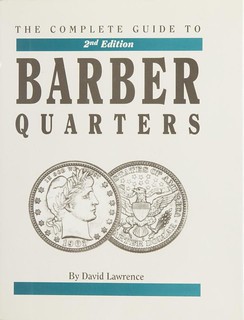 The Newman Portal this week
passed the 25,000 document milestone. The 25,000th document added was The Complete Guide to Barber Quarters, 2nd edition, published by DLRC Press (David Lawrence Rare
Coins) in 1994. This particular copy was David Feigenbaum’s (DLRC founder) personal copy and was loaned for scanning by John Brush, President of DLRC. This volume provides an
overview of the Barber quarter series, details major varieties, pricing history, and describes diagnostics for key issues such as the (commonly forged) 1901-S. Today this study is
continued through the journal of the Barber Coin Collectors Society.
The Newman Portal this week
passed the 25,000 document milestone. The 25,000th document added was The Complete Guide to Barber Quarters, 2nd edition, published by DLRC Press (David Lawrence Rare
Coins) in 1994. This particular copy was David Feigenbaum’s (DLRC founder) personal copy and was loaned for scanning by John Brush, President of DLRC. This volume provides an
overview of the Barber quarter series, details major varieties, pricing history, and describes diagnostics for key issues such as the (commonly forged) 1901-S. Today this study is
continued through the journal of the Barber Coin Collectors Society.
The 25,000+ documents on Newman Portal comprise over 2 million pages. Among the collection is the largest group of digitized U.S. Mint material from the National Archives (nearly a quarter million pages), and almost 8,000 auction sale catalogs with nearly complete coverage of the auction catalogs listed in John Adams’ United States Numismatic Literature (2 vols., 1982, 1990), scanned primarily at the American Numismatic Society library. In addition we host back issues of numerous collector organizations and societies.
We’re not stopping there! Work continues on the (seemingly endless) Eric P. Newman research papers, the David Lisot video library, and the contributions of a large number of private authors and organizations who continue to build Newman Portal through their generous donations of digital content and printed material.
Link to The Complete Guide to Barber Quarters, 2nd edition:
Chris Fuccione writes:
I think it is great that they were able to hit this milestone in such a short amount of time. It shows the dedication of the people that are scanning and the individuals, clubs, and organizations that have donated items to be scanned. I am happy that the Newman Numismatic Portal has become embraced and accepted in the numismatic community.
The first results of a project begun in March, 2015 to investigate the composition of early U.S. silver coins have been published. David Finkelstein and Christopher Pilliod have released a paper summarizing the first phase of a multi-phase project to determine the chemical composition of 1794 and 1795 US silver coins.
The pair gave a presentation at the John Reich Collectors Society (JRCS) General Meeting during the ANA World’s Fair of Money in Philadelphia. Here's an excerpt from the paper's introduction, and a link to the complete document on the Newman Numismatic Portal. -Editor
Most numismatists will agree that the single most important Mint related legislation in our nation’s history was the Mint and Coinage Act of April 2, 1792. In addition to establishing the first Mint of the United States, one of the key aspects of this law was Congress’s mandate for the composition of the silver coins. Per Section 13:
The law specified that silver coins were to contain 1485 parts of pure silver and 179 parts copper alloy. This equated to a standard of 1485 / 1664 or 89.24278% or 89.24+% pure silver, and 10.75722% or 10.76-% copper alloy.
Multiple documents stored within the National Archives and Records Administration (NARA) and the Library of Congress indicate that under the leadership of Mint Directors David Rittenhouse and Henry William de Saussure, some or all of the 1794, and most or all of the 1795 dated silver coins were produced to a 90% silver and 10% copper standard. Then, effective November 6, 1795, under the leadership of its third Director, Elias Boudinot, the Mint reverted to the 89.24+% silver and 10.76-% copper standard.
The first phase of a multi-phase project was just completed to determine:
1. what elements and percentages are in the silver coins of 1794 and 1795,
2. what elements and percentages are in the copper coins of 1794 and 1795,
3. whether the Mint attempted to refine any of the silver bullion deposits made during 1794 and 1795 to a standard of 89.24+% silver and 10.76-% copper as per the Mint and Coinage Act of April 2, 1792,
4. whether the Mint attempted to refine any of the silver bullion deposits made during 1794 and 1795 to a standard of 90% silver and 10% copper, thus violating the Mint and Coinage Act of April 2, 1792,
5. whether Mint personnel were capable of achieving a refining target of 89.24+% silver and 10.76-% copper,
6. whether Mint personnel were capable of achieving a refining target of 90% silver and 10% copper,
7. the technologies available to 18th century precious metal refiners, and
8. the Mint’s practices for refining silver bullion deposits.
This project began in March, 2015. Thanks to support from the Eric P. Newman Numismatic Education Society, Heritage Auctions, and the Terry Brand Estate, modern chemical analysis technologies were used to determine the chemical compositions of 1794 and 1795 silver and copper coins. Based on the compositional results, statistical analyses were performed, and preliminary conclusions were made.
To read the complete article, see:
E-Sylum readers got a preview of the methodology last month in a report from Newman Numismatic Portal Project Coordinator Len Augsburger. -Editor
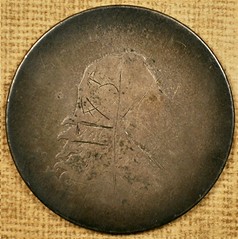
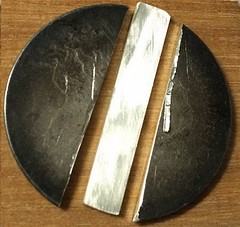
Before and after pictures of a 1795 O-105 Half Dollar. The center piece in the after picture was sent for ICP-AES analysis.
To read the complete article, see:
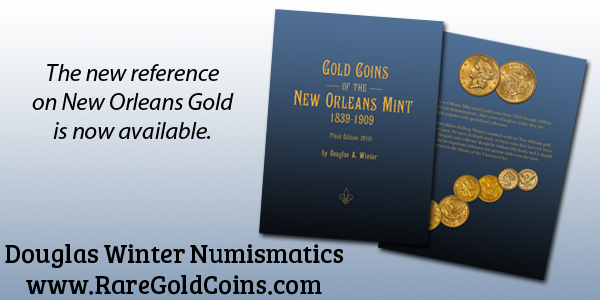
David Lisot was everywhere at the September 2018 PAN show in Pittsburgh. Here are links to the published videos on a great variety of topics. Check 'em out. More to come later. -Editor
1715 Fleet Treasure Coins on Display at PAN Coin Convention

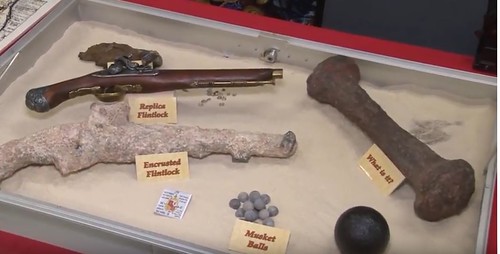
Ben Costello, Director, 1715 Fleet Society, David Lisot, Interviewer, CoinTelevision.com.
The Pennsylvania Association of Numismatists Coin Convention has a lot for collectors to see. Ben Costello shows items recovered from Spanish galleons wrecked in 1715 in a mighty hurricane that include pieces of eight and much more.
The 1715 Fleet Society puts on a GREAT exhibit, even allowing visitors to touch items recovered from the wrecks. Very nicely done and always a hit with the general public. -Editor
To watch the complete video, see:
Cool Coins & Currency! PAN Fall Coin Convention 2018
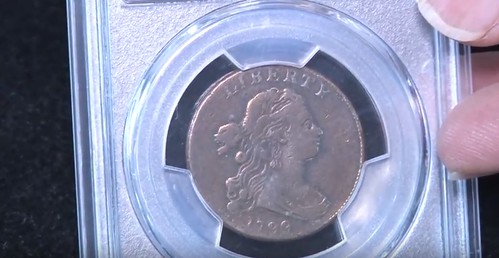
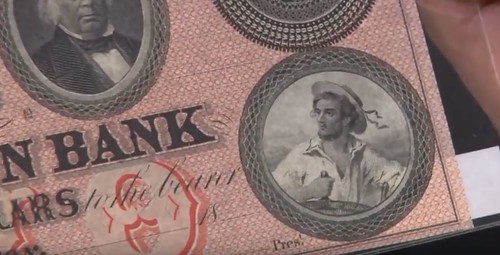
David Lisot, Interviewer, CoinTelevision.com with
- Steven Ellsworth, 1793 Chain Cent, PCGS XF Details, 1793 Half Cent, PCGS VG08, 1799 Large Cent, PCGS F12, Sheldon-189 and
- Rob Lehmann, 1880-S Morgan Dollar, PCGS MS65 Toned, $20 Stonington Bank Obsolete Bank Note, Uncirculated, and 1930 Graf Zeppelin Stamps, 65¢, $1.30, $2.60 in Very Fine condition.
To watch the complete video, see:
More Cool Coins & Currency! PAN Fall Coin Convention 2018
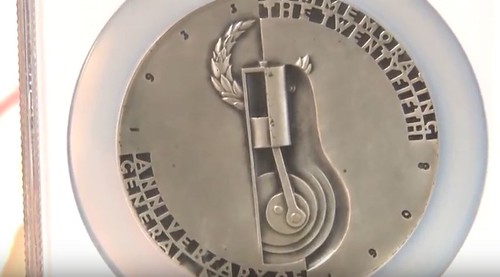
David Lisot, Interviewer, CoinTelevision.com with
- Ben Costello, Director, 1715 Fleet Society, Silver Pieces of Eight Treasure,
- Tom Cunningham, 1933 General Motors 25th Anniversary silvered art deco medals,
- Lew Fortwangler, Circulated Large Cent, and
- Andrew Graber, Jersey 1909 Twelfth Shilling PCGS MS63 RB, German East Africa 1913-A Half Rupie Silver PCGS MS62,
Lot of nice items here. Pictured is the art deco 1933 General Motors medal. Cool piston action! -Editor
To watch the complete video, see:
Exonumia Comes to PAN Convention

Paul Cunningham, Owner, Cunningham Exonumia, David Lisot, Interviewer, CoinTelevision.com.
Coin collecting is more than just coins. The numismatic hobby includes tokens and medals that are called Exonumia. Find out about these pieces of history that each tells a story from one of the leading Exonumia dealers.
To watch the complete video, see:
PAN Coin Show Benefits Collectors & Dealers
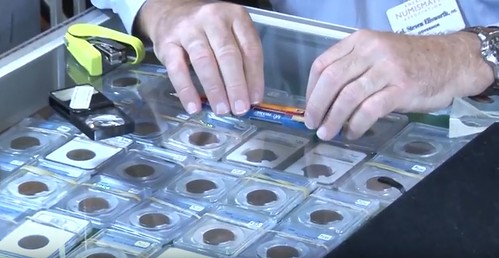
David Lisot, Interviewer, CoinTelevision.com with Ben Costello, Steven Ellsworth, Andrew E. Graber, & Rob Lehmann.
The Pennsylvania Association of Numismatists offers a world of benefit to collectors and dealers. Find out from these recent PAN Convention participants.
To watch the complete video, see:
PAN Coin Show Caters to Kids!
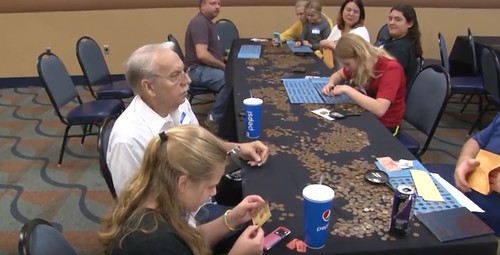
David Lisot, Interviewer, CoinTelevision.com.
The Pennsylvania Association of Numismatists has special programs for kids of all ages to get them started on coin collecting. Hear from some of these young coin warriors why they are fledgling numismatists.
PAN puts on wonderful programs for new collectors, including the penny search tale -Editor
To watch the complete video, see:
Readers Respond: Contemporary Counterfeit Coins
Winston Zack writes:
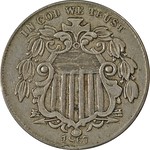 I wanted to let
you know that over this first week since you included in The E-Sylum my request for information related to my counterfeit coin book project I have received an outpouring of
support from readers, above and beyond my realistic and hopeful expectations. Somewhere between 15 and 20 readers have so far contacted me with images, background information and
other stories which I was unaware of despite what I thought has been fairly extensive research. I could not be happier with the results so far and I look forward to any future
readers who reach out to me. Thanks!
I wanted to let
you know that over this first week since you included in The E-Sylum my request for information related to my counterfeit coin book project I have received an outpouring of
support from readers, above and beyond my realistic and hopeful expectations. Somewhere between 15 and 20 readers have so far contacted me with images, background information and
other stories which I was unaware of despite what I thought has been fairly extensive research. I could not be happier with the results so far and I look forward to any future
readers who reach out to me. Thanks!Thanks, everyone. As noted last week, Winston is in the editing stages of a book on circulating contemporary counterfeit U.S. coins. See the earlier article for more information. He may be contacted at
winston.s.zack@gmail.com . -EditorTo read the earlier E-Sylum article, see:
Fake 1803 Harrison Silver Indian Peace Medal
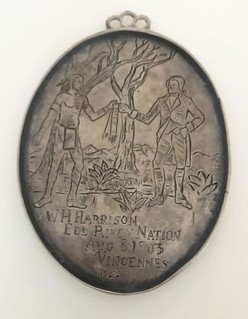
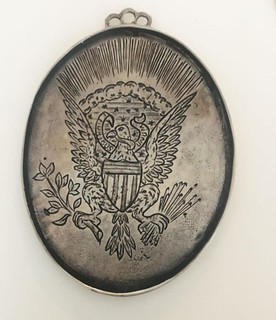
And speaking of counterfeits, three prominent readers have weighed in on the Harrison Silver Indian Peace Medal pictured last week, and they concur with my conclusion. -Editor
Dealer Rex Stark writes:
The 1803 peace medal is a worthless fantasy.
Dealer Tony Terranova writes:
Pure fantasy. Not old. Engraving very poorly done. Etc.,etc.,,etc,,,etc.
Collector Alan V. Weinberg writes:
As to the 1803 Harrison oval Indian Peace medal, I've physically seen at least 6-7 examples and they are cast fantasies and rather crude at that and have appeared on eBay. They started appearing at least four decades ago and may have originated in the 1960's Ohio-sourced glut of fake oval IPMs.
The Ohio-based glut of fake ENGRAVED oval IPM's was very dangerous. The initial supply was in fact hand-engraved and very well done. Also, about the same time, extraordinarily deceptive engraved fake ovals were coming out of England and those European oldtime hand engravers were very skilled. Such skill allegedly no longer exists. The Ohio source and the English source may well have been connected.
I might add that the John J. Ford Jr. collection, auctioned by Stack's over a decade 2003-2013, had three oval engraved IPM's one of which the catalogue stated Ford paid over $32K for. It was fake and catalogued as such, selling for well under $10K to an E-Sylum reader and I understand later donated to the ANS. This would be one of the very few times Ford, quite a knowledgable buyer, was "taken".
Thanks, everyone. -Editor
To read the earlier E-Sylum article, see:
More on Leatherbound French Catalogs
Last week Jan Valentine summarized his informal research indicating that seven leatherbound examples of the B. Max Mehl Dr. French collection fixed price list are known. -Editor
George Kolbe writes:
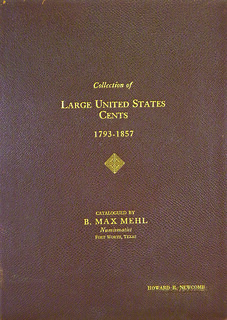 For the fun of it, I
searched Kolbe & Fanning auction sales since 1988 for sale appearances of the deluxe leather edition of B. Max Mehl’s Geo. P. French collection of large cents.
For the fun of it, I
searched Kolbe & Fanning auction sales since 1988 for sale appearances of the deluxe leather edition of B. Max Mehl’s Geo. P. French collection of large cents.
I found seven different examples, some offered more than once. They may be the same seven recorded by Jan Valentine, however five of them feature the recipient’s name stamped in gilt on the lower front cover. Namely: Howard Newcomb, Col. E.H.R. Green, W.A. Philpott. Jr., Waldo Newcomer, and A.A. Grinnell. Jan records four with the collector’s name stamped on the front cover. The remaining two belonged to H.A. Sternberg and B. Max Mehl. The former is inscribed to the recipient; the latter was sold as part of the Ron Stocker collection of B. Max Mehl memorabilia in 1983 and features notes by B. Max and an annotation by him.
Useful information. David Fanning kindly provided the above image. Thank you! -Editor
To read the earlier E-Sylum article, see:
More on the Guide Book to the Guide Book
Gary Dunaier writes:
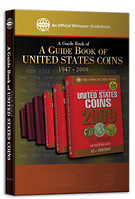 I've long been
interested in an update to Frank Colletti's A Guide Book of The Official Red Book of United States Coins. That's proven by the fact that the linked "earlier
E-Sylum article," responding to a letter I sent you... was published in 2010!
I've long been
interested in an update to Frank Colletti's A Guide Book of The Official Red Book of United States Coins. That's proven by the fact that the linked "earlier
E-Sylum article," responding to a letter I sent you... was published in 2010!
In January of this year I e-mailed Whitman's Dennis Tucker and expressed my interest in a new edition. This was his response:
"Thank you for sharing your thoughts on the Bowers Series. The Guide Book of the Official Red Book of United States Coins is one of my favorites in the series - I still have the first Red Book I ever bought, and it's one of my treasured possessions. I like the idea of an updated second edition of the GBGB, as we affectionately call it here at Whitman. (Pronounced "jeebie-jeebie.") A lot has happened since the first edition was published! I'll add your feedback to our notes."
Well, good things come to those who wait. Just no telling how long that might be - the market imposes its own set of priorities. I'll pass along any information I get about a possible 2nd edition. -Editor
To read the earlier E-Sylum articles, see:
NOTES FROM E-SYLUM READERS: SEPTEMBER 23, 2018 : Red Book Pricing (http://www.coinbooks.org/v21/esylum_v21n38a12.html)
Lima Mint Engraver G.M. Sought
Bruce W. Smith writes:
The Lima Mint in Peru had an engraver in the 1920's and 1930's whose initials G. M. appear on some coins and medals. What is the name of this engraver? I think his initials also appear on some coins of Ecuador and a 1921 medal for the centennial of Independence of Peru. I can't find his name in the books I have. Thanks.
Can anyone help? -Editor

Author Dave Lange researches the history of coin collecting boards and albums. With permission, here are a couple excerpts from his Fall 2018 Coin Board News email newsletter. Thanks. -Editor
NATIONAL ALBUM BONANZA! While at the recent Long Beach Expo I was amazed to see that the supply dealer had a mountain of Raymond National album pages for sale, nearly all of them NOS (new, old stock). I bought just a few pieces for my own collection, since it's so far along that there isn't much I don't already have. If you're looking for some really clean National pages, contact the owner at coinbuyer@cbcoins.com, 909-624-4250.
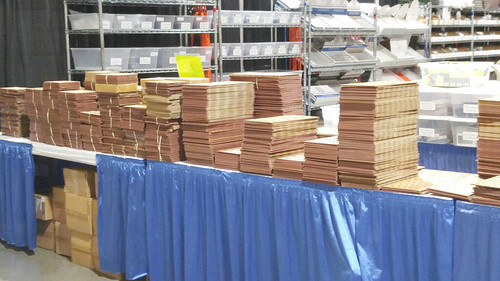
RETAIL ROUNDUP Finally, I'll leave y'all with a selection of vintage coin board ads from the 1930s/40s.
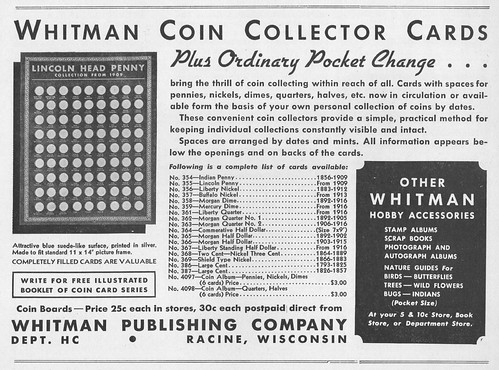
I've only included one of Dave's classic ad images. This one is from Hobbies magazine, June 1938. -Editor
To visit Dave's web site, see:
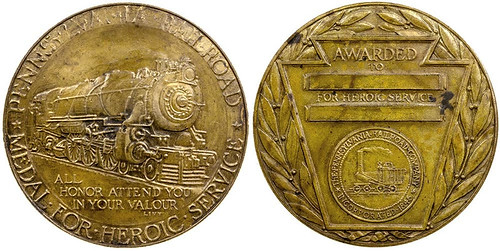
Paul Moller writes:
I am a collector in Calgary Alberta and have come upon a Pennsylvania Railroad Medal for heroic service. It has no name engraved so it is obviously an unused blank. I was told you might have some knowledge or history of this medal. Any help learning what this is would be appreciated.
Well, I'm afraid I've never seen this one before. The only mention we've had in The E-Sylum is to an exhibit at the 2013 American Numismatic Association World's Fair of Money in Rosemont, IL. A search of the Newman Numismatic Portal uncovered two listings in a Stack's Coin Galleries sale on 4/15/1998 (lots 1551 and 1552). Lot 1551 is illustrated and it is also unawarded. Below is the lot description. -Editor
Pennsylvania Railroad Historic Service Medal. 1922 Bronze 70mm. Uncirculated. steam locomotive, 1922 on cab, headlight, quote from Roman sage Livy. Rv. Keystone, award inscription. Red-gold patina. Struck by Medallic Art Co.
Lot 1552 is described as "A second example of this powerful design", and I agree with that assessment. Great medal. The prices realized are $330 and $357.50, respectively, hefty prices for 1998. Perhaps readers can fill us in on more recent sales records. Who designed this piece?
Some 51 issued examples are mentioned in a 1926 article found online. Here's an excerpt. -Editor
Decision to award medals to employes of the Pennsylvania Railroad, who perform unusual acts of heroism in connection with their regular duties, or while on the Company's property, was announced July I, 1923, by G. L. Peck, Vice President in Charge of Personnel, following authorization by the Company's Board of Directors.
The motive of the Directors in establishing the award was to accord proper public recognition to those who, in connection with the discharge of duty, perform extraordinary service in the protection of life or property at the risk of their own safety or even of their lives.
Referring to the purposes of the Directors in authorizing the award of medals for heroic service, Mr. Peck said:
"Notwithstanding the provisions of mechanical safeguards, the nature of railroading itself is such that opportunities to protect life, limb and property occur in the ordinary course of a day's work, and Pennsylvania Railroad men have never been found wanting in the performance of their duties in this respect.
"The record of the Pennsylvania Railroad in protecting the life and property of its passengers, shippers and employes is an achievement of which the management is justly proud. It is a tribute to the zeal and fidelity of Pennsylvania employes."
Recommendations for the award of Heroic Service Medals are made by employing officers to a special committee which, in turn, investigates the merits of each case and then makes a recommendation to the Board of Directors. All officers and employes are requested to report any act of heroism which they believe merits consideration by the special committee.
Henry M. Crossman, of East Aurora, N. Y., a machinist in the Ebenezer shop, Buffalo division, is the father of the Pennsylvania Railroad medal for heroic service. It was from Mr. Crossman's suggestion that the plan of awarding medals, as finally authorized by the Board of Directors, was developed.
A general notice to all employes of the Central Region was issued in November, 1921, by Vice President J. A. McCrea, now dead, officially commending an outstanding act of heroism performed by a crossing watchman in saving a little girl from being run over by a passenger train. After reading this notice, Mr. Crossman wrote to Mr. McCrea and suggested that medals of appropriate design be awarded in the future, in cases similar to the one described in the general notice. He also suggested that presentation of a medal such as he had in mind should be made in a formal ceremony.
Mr. McCrea recognized the merit of the general plan as outlined by Mr. Crossman and he later submitted a recommendation to the Board of Directors. The plan was favorably received and the award of medals for heroic service was formally authorized after a detailed program of procedure had been worked out and an appropriate design for a medal developed.
Awards of the medals have thus far been made on two occasions. The more recent was February 10, 1926, when twenty-four were presented. The first was on May 28, 1924, when twenty-seven medals were awarded. In each case, the presentations were made by the President of the Company in the presence of the Board of Directors and the higher executive officers.
I also reached out to medal researcher Harry Waterson. -Editor
Harry Waterson writes:
I own one of these medals (unnamed) but the real maven is George Cuhaj. He has chapter and verse on these medals. In fact, he has bios of all the recipients. I suspect George was the exhibitor in 2013 in Rosemont.
Indeed George was the exhibitor and he has a great deal of information on thee medals. Below is a short excerpt of what he was able to send me. -Editor
Harry is right. I've been a bit over the top on these medals, having published articles in both the TAMS Journal and the Keystone publication of the Pennsylvania Railroad Technical & Historical Society, as well as an educational exhibit.
The medals were struck by Gorham & Co.
PRR records (split between the PA state archives in Harrisburg and the Hagley Museum & Library in Wilmington) record 111 were presented starting in 1926 (for actions going back to 1923) and 1953. The pre-war medals use an insert die technique for placement of the name and date of event, the postwar medals observed have the name and date engraved. Two heroism events between 1954 and 1957 note in the employee publication that only a Carnegie Medal was awarded (Some PRR folks received both, others did not).
This makes the sixth unawarded medal known (The ANS has one).
One named medal is known from 1928 for which there is no documentation (applications in archives) or board minutes (citations were read into the minutes and medals presented at the end of board meetings).
I have developed a 36 page booklet listing a nice history and award citations.
George supplied a great deal of information, but I'll just add this fantastic image of a Long Island Railroad awarded medal. Thanks! -Editor

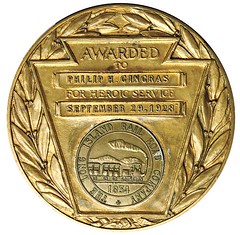
To read the complete article, see:
_for_Heroic_Service_1926_Article_Reprint.html)
To read the earlier E-Sylum article, see:
To read the complete Coin Galleries auction lot listing, see:
Dick Johnson submitted this remembrance of numismatic literature dealer Frank Katen. Thanks! -Editor
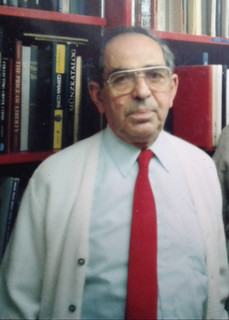 The photos in last weeK’s E-Sylum
of Dave Hirt and Editor Wayne Homren’s visit with Frank Katen brought back memories of the long-time numismatic book dealer. I too visited him but this was at his home in
Washington DC.
The photos in last weeK’s E-Sylum
of Dave Hirt and Editor Wayne Homren’s visit with Frank Katen brought back memories of the long-time numismatic book dealer. I too visited him but this was at his home in
Washington DC.
Frank Katen lived in Milford Connecticut when he was first involved in the coin business, and married to his first wife. He moved to DC and married to his second wife, and ultimately to Silver Springs, Maryland with his third wife, Laurese (a delightful lady who was a collector of frogs - I sold her medals with frogs on them).
Katen ran his numismatic book business from his home in Northwest Washington DC. He showed me his library the day I visited. The books he sold often had a bookplate “Duplicate from the Frank Katen Library.” I suspect some of these bookplates still exist. He also showed me his card catalog which contained the price and source of every numismatic book he had.
I tossed off a line in an attempt to compliment him “Wow, I wished I had that.” Months later I got a call from his wife who had remembered my comment. “Would you like to buy that card catalog for a thousand dollars?”
Later in the evening when I knew Frank would be home I called and asked him if he was indeed selling his card file. He exploded. He knew nothing of this. It seems the couple were separating and she was trying to sell any of his assets she could. He thanked me for contacting him. The couple did get a divorce. Frank kept his card file and remained in the numismatic book business.
But that is not the end of my Frank Katen story,
Years before in New York John J. Ford had purchased the rights to the “Standard Catalogue of U.S. Coins” from Wayte Raymond. John intended to continue its publication, updating it and adding new features. He knew of my interest in numismatic books and asked me to compile a section on American numismatic books to be included in the Standard Catalogue. I did and sent it to him. But he never published that Standard Catalogue.
Years later, in 1961 I was editor of Coin World. To generate interest I created special editions. The first was on the Civil War, its coins, tokens and paper money. For a subsequent issue I chose numismatic books and dusted off that old manuscript of American numismatic books I had prepared for John Ford. I listed books on one long line in tabular style. I ran a second book special issue before I left Coin World.
It was popular enough to run again. So Margo Russell, then editor, wanted to update it. Who did she ask? Frank Katen. It ran under his name only with no mention of my previous authorship.
To read the earlier E-Ssylum article, see:
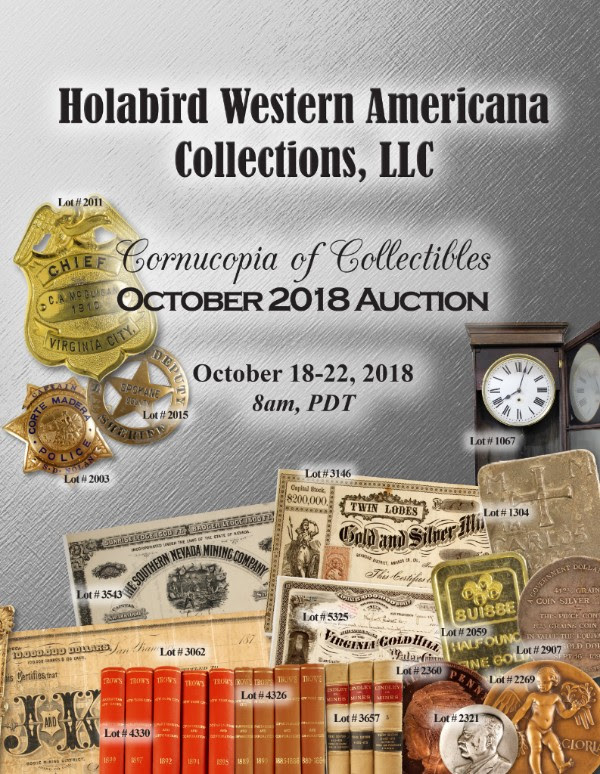
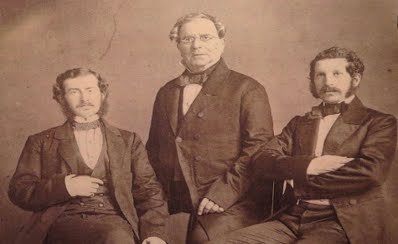
Photograph of the Viti family : (Center) Vito Viti ;
(Left) Francis A. Viti ; (Right) Alonzo M. Viti.
For the American numismatic historian, on the surface, Vito Viti was an Italian immigrant who lived in Philadelphia for nearly fifty years from 1817 - 1866, as an importer of European artworks. He was a sculptor and importer of antiques, antiquities, Italian and French art, and documented as having held two auctions in 1824 that contained a collection of ancient coins. It seems highly probable that on his numerous trips to Europe he continuously brought back ancient as well as other European coins and medals for collectors in the United States, and that many of his auctions most likely also contained these coins and medals that went unlisted in his newspaper advertisements. None of his auction catalogues are extant. It does not seem coincidental that the coins offered for sale in the famous so-called A. C. Kline sale held at Moses Thomas, June 12-13, 1855, neatly and conveniently fit the description of coins most likely to have been acquired from Vito Viti or of Vito Viti himself.
Vito Viti first came to America and settled at Virginia at age twenty-nine. He arrived from Lisbon to America at the port of Alexandria on November 17, 1816, and began working for Nicola Fiengo & Company at Baltimore, Maryland. He either met Fiengo in Lisbon or else was already associated with him there or previously since a record of Fiengo importing goods for sale in Lisbon appeared in the Gazeta de Lisboa, No. 40, February 15, 1816. Regardless, one year later we find him as an independent art importer and dealer selling his wares in Georgetown, Washington, D. C., since Fiengo moved to New York opening the "Italian Gallery" on Broadway.
The following year he developed business at Philadelphia, which had been established between Stephen Girard (1750-1831), an importer of that city and his brother Antonio Viti, an alabaster artist of Volterra. Antonio Viti used to ship his sculptures and other merchandise from Genoa and Leghorn to the Port of Philadelphia. Vito Viti began importing goods into Philadelphia as early as 1818. Although Vito Viti set up both a residence and store in Philadelphia he also maintained stores in other states including New York City, Hartford, Connecticut, Salem, Massachusetts, Charlotte, South Carolina, and New Orleans, Louisiana. He was not only a frequent traveler within the United States selling his imported goods but also a frequent traveler into Europe buying goods in various countries and always returning to his family villa at Volterra.
Two of the earliest known numismatic auctions held by Vito Viti took place in 1824. The first was held at Mills & Minton Auction House, Philadelphia on 6 April, 1824; the second from 5-6 May, 1824 at New York. Details from John N. Lupia, III, American Numismatic Auctions to 1875 (2013) : 76-77.
He died August 9, 1866 at his home 513 South 4th Street, Philadelphia. His funeral services were held on Tuesday, August 14, 1866, at 4 P.M., at St. Joseph Catholic Church, Philadelphia. He is buried in the Old Cathedral Catholic Cemetery.
To read the complete article, see:
The entire inventory of the Lupia Numismatic Library is for sale. Individual items will be available before the remaining archives are broken up into parcels sold at philatelic auctions in the U. S. and Hong Kong. Check
NumismaticMall.com frequently as dozens of new items with estimates will be posted daily until everything is sold.All inquiries will be given prompt and courteous attention. Write to:
john@numismaticmall.com . HARVEY STACK'S NUMISMATIC FAMILY, PART 27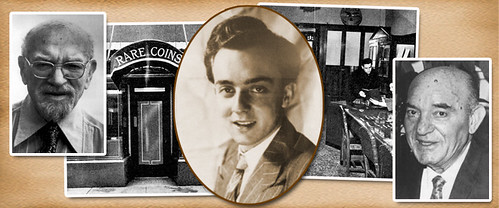
More collectors continued to be attracted to numismatics in 1959. The price for Proof sets and Mint sets of this year remained close to face value at the Mint. Speculation in these sets went on. Old time collectors bought these sets from the Mint or from a dealer like Stack’s in order to keep their collections up to date, while at the same time acquiring the other coins they needed for their growing collections. Young collectors searched through their change to fill the popular 25¢ boards. They would then have to find the scarce and rare dates to fill the albums, which led to more advanced collecting. Dealers maintained a general stock for beginners as well as providing scarce and rare dates and mints to more advanced collectors.
Quite a few stores evolved, of every type from small local hobby shops to advanced dealers like our company. The market seemed to flourish as collections grew, benefiting from old time collections that were sold as collectors lost interest, moved on to something new, or passed away. Stack's had been around for a quarter of a century and our firm had built friendships and provided services to a good number of the collectors who had been in the hobby since the early 1930s.
Our company was also lucky to obtain, with many of the cabinets we sold, the libraries collectors had built and used for reference as they developed their collections. Our library grew so that it had to be housed on two different floors, the United States portion on the first floor and the foreign and ancient library on the second. We made our library available for use by collectors and they often became friends as they developed in the hobby. The use of the library, the other services we offered, and the relationships we built caused Stack’s to be selected to buy and sell for these collectors.
My uncle Joe (Joseph B. Stack) used to say to many who came to visit: “You know that the coin I just sold you really is on loan to you, for someday I hope to get it back to sell to another collector.” All who heard that remark used to laugh, but it did sum up an important role we played in the market and gave buyers an idea for what they could do in the future.
In 1955, in order to help my uncle sell at auction, both Ben and I had become licensed Public Auctioneers, and were given the chance to sell whenever my uncle tired on the stand. One of the earliest sales I remember auctioneering was at a New England Numismatic sale in Hartford in 1957. For this event I took several members of our staff, together with the coins to be sold, and performed the whole sale myself. My uncle’s training provided the skills needed to be a Public Auctioneer, and I was proud to have been able to perform this auction all on my own without any mishaps.
Stack’s auction season for 1959 included the Pelletreau Collection, the T.K. Harvin Collection, the Philip Straus Collection, the Thetford Collection, the Wilson Reuter Collection and the Powers Collection.. The Pelletreau Collection, at the time owned by Robert Pelletreau of Long Island, had been started by his father in the depression years of 1933-1934. Robert's father was a lawyer who was established in Patchoug, Long Island. After his father passed away Robert continued as a lawyer in the area, and worked on his father's collection on weekends.
Robert would travel to New York City about once a month, on the Long Island Rail Road, and spend several hours visiting Stack's, with my father Morton always helping him. The collection grew and became very comprehensive. His father had bought some of the coins from dealers like B. Max Mehl and Wayte Raymond, and later many came from Stack's as we became a source for additions.
The Robert Pelletreau Collection of primarily copper, silver and gold coins had many scarce and rare coins that also offered important pedigrees. It was complete in the minor issues, and featured rarities and high quality. Included was an 1876-CC twenty-cent piece as well as half dollars of 1795 (3 leaf), 1796, 1797, 1838-O, 1878-S, and an 1884 trade dollar, along with many other coins, mostly in Proof or Mint State. In my next article I will tell of some of the other collections that crossed the block at Stack’s in the last year of the 1950s.
To read the complete article, see:
Here are excerpts from a couple articles about the designer of Canada's new Fancy Dance coin. -Editor
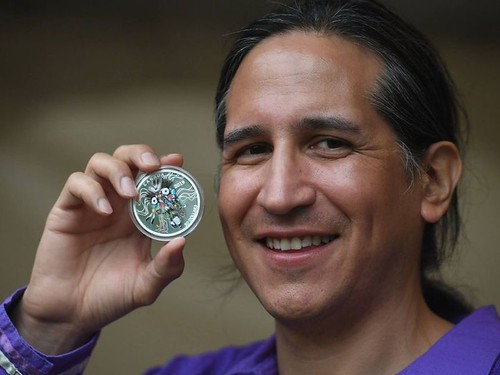
It’s a hobby for Garrison Garrow, and his efforts are renowned.
Garrow, of Akwesasne, designed the new Royal Canadian Mint collector coin ($30), which was unveiled recently at McGill University in Montreal.
Garrow, 44, lives in Ottawa, where he’s a photographer and historian.
The McGill Reporter newspaper recently told the story of Kanien’keha:ka artist Garrow and the development of the the Royal Canadian Mint’s Fancy Dance coin. The new coin depicting an Indigenous dancer was unveiled as part of McGill’s First People’s House 17th annual Powwow.
To read the complete article, see:
Here's more from the McGill Reporter article. -Editor
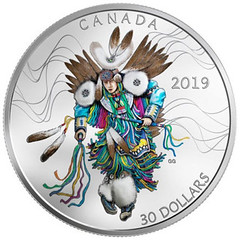 The vividly coloured silver
coin depicts the pageantry of the Fancy Dance, a modern Indigenous art form that is a powerful expression of Indigenous pride and heritage. Fittingly, the unveiling ceremony took
place just moments before the opening of First Peoples’ House 17th Annual Pow Wow.
The vividly coloured silver
coin depicts the pageantry of the Fancy Dance, a modern Indigenous art form that is a powerful expression of Indigenous pride and heritage. Fittingly, the unveiling ceremony took
place just moments before the opening of First Peoples’ House 17th Annual Pow Wow.
A male dancer dominates the 2-ounce coin’s face, with finely detailed engraving adding a sense of movement and splashes of colour highlighting the intricate nature of his regalia. As the image’s creator Kanien’keha:ka artist Garrison Garrow, explained to the crowd at the unveiling, details of the regalia have been pulled from various Indigenous people’s traditions, from the Thunderbird of the Plains peoples to the Iroquois design on the apron.
“It was a difficult challenge to do this design because it is a Fancy Dance and there is a lot of energy in that dance and there is a lot of power,” said Garrow. “I wanted to try and capture some of that in a static image. I hope that I did that.”
Mark Miller, Member of Parliament for Ville-Marie—Le Sud-Ouest—Île-des-Sœurs, praised the coin for its craftsmanship but also for its symbolism. “Federal governments banned this type of regalia that people wear so proudly today. It’s being brought back from a very dark place,” said Miller. “Our governments, our people, were complicit in putting it down. Today is but a symbolic gesture – but a very important one – to keep shining the light on the beauty in the traditions that keeps the culture, the language and the lives of people vibrant.”
To read the complete article, see:
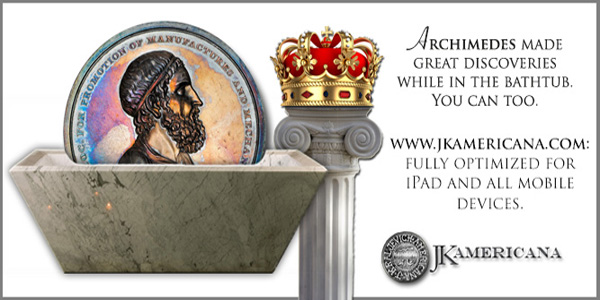
In a September 26, 2018 Mint News Blog article, author Dave Bowers acknowledges recent research and analysis surrounding what he now deftly avoids calling a "dollar" or "coin" - the the 1776 Continental Currency item. With permission, here is the complete article.
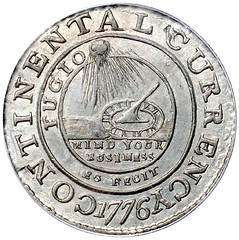
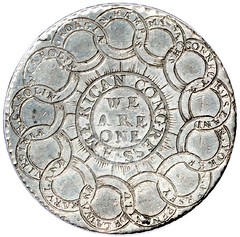
What for well over a century numismatists considered to be a federal coin, although [no] documentation was found, is now determined to be a medal. The item in question is the 1776 Continental Currency item. Although hundreds exist, the demand for them by collectors is seemingly insatiable, and whenever a decent example comes on the market it is an object of attention and desire.
Conventional wisdom by most past writers including me, Eric P. Newman, and 101 others, is that these were struck in America in 1776 as a more durable substitute for the paper Continental Currency dollar. The designs with the Sun, sundial, legend FUGIO, and names of the colonies are the same as on the paper bill. The initials E.G. on some of the coins are those of Elisha Gallaudet, New Jersey engraver, per the research of Eric P. Newman.
Last year and early this year the traditional numismatic applecart was turned upside down. No numismatic record of such a coin was found, such as in the collection of Pierre Eugene de Simitière formed in that era. Beginning in 2012 with a find by Robert D. Leonard suggesting it was not a federal coin, other researchers including Erik Goldstein, Christopher McDowell, and David McCarthy found that the Continental Currency pieces first appeared in England several years later and were bought and sold there as medals.
What does this mean to the numismatic future of the medal? Time will tell. However, the 1778-9 Rhode Island medal is in the Guide Book and has been highly desired for a long time by collectors of colonial coins.
If you wish to reach out to me for commentary, questions, or suggestions, I can be contacted via e-mail at qdbarchive@metrocast.net.
To read the complete article, see:
Ever since the bankruptcy of their parent company was announced, the fate of the Medallic Art Company has been up in the air, causing much concern in the numismatic field. But a new chapter has begun - the ANS has announced their acquisition of the company's vast archives. Here is the press release. Great news! -Editor
The American Numismatic Society has announced the acquisition of the archives of the Medallic Art Company, one of America’s oldest and most important private mints.
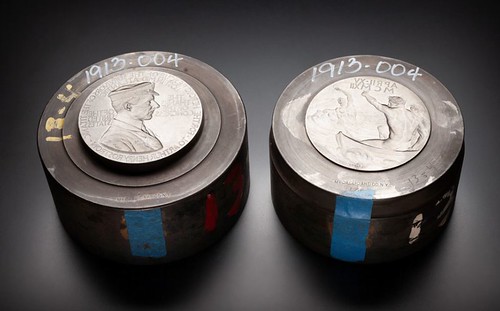
Dies for the Congressional Medal of Honor awarded to Captain Arthur Henry Rostron for the rescue of victims from the sinking of the Titanic. It was sculpted in 1913 by John Flanagan who would later design both sides of the Washington U.S. quarter-dollar coin.
The archive, which consists of more than 50,000 individual items such as medals, dies, galvanos, plaques, and paper and digital archives, was sold to the Society for $420,000 in bankruptcy proceedings of the Northwest Territorial Mint (NWTM) in a Seattle court. NWTM, which also operated a bullion business from its facilities in Dayton, Nevada, went bankrupt in 2016.
The Society’s interest was initially focused on recovering MACO’s dies, which had been used for decades to manufacture famous award and art medals, but once the ANS realized the full extent of the holdings for sale, the main aim became to rescue everything that would allow the Society to reconstruct the history of this important company.
The Medallic Art Company was founded in New York City around 1907, and for more than a century it produced the work of America’s finest artists, as well as served countless non-profit and for-profit institutions in their desires to produce commemorative, award, and other medals. Until its demise, many of the most famous awards in the United States—including the Pulitzer Prize Medal, the Randolph Caldecott medal, and many of the official medals of Presidential inaugurations—were produced at the Medallic Art Company.
Scores of notable portraits were also made there, commissioned from many of the most famous artists of their day. The beautiful medals and larger galvanos they left represent an almost complete Who’s-Who of 20th-century America. In addition, many major companies had logos turned into medallic or sculptural plaques by MACO.
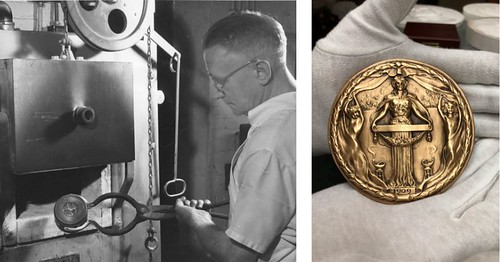
The moving and storage of this mass of material, much of it made of steel, copper, or other metals, proved a major challenge. The ANS was fortunate to have a partner in Medalcraft Inc. and its CEO, Jerry Moran, who had purchased the more recent dies (of medals created after 1998). The roughly 20,000 older dies were shipped to the headquarters of Medalcraft in Wisconsin, and ANS will discuss with Medalcraft the future of these dies over the coming months.
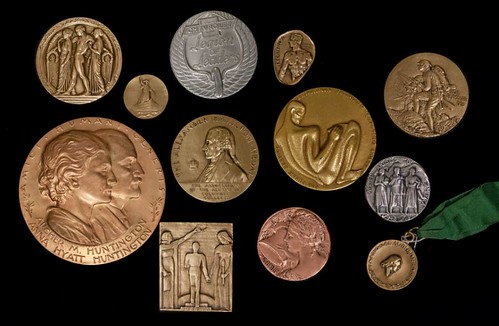
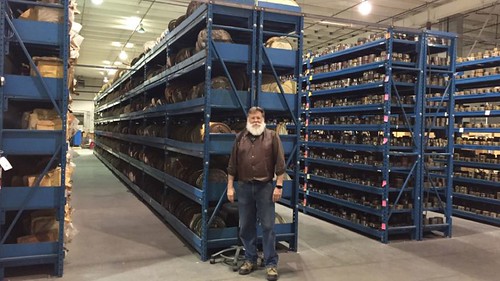
Rob Vugteveen in front of the shelves of dies and galvanos
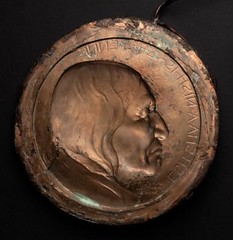
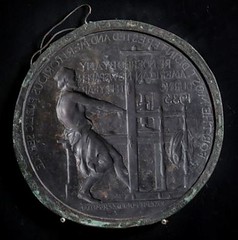
LEFT: Galvano for one of Edward Warren Sawyer’s portrait medals of Native American leaders. This portrait of Esh-Sha-A-Nish-Is of the Cheyenne Nation was made in 1912.
RIGHT: The galvano for the reverse of the Pulitzer Prize sculpted by Daniel Chester French and Augustus Lukeman in 1917.
An equally demanding task will be the selection of galvanos and die-shells for the Society’s permanent collection. The approximately 15,000 such items, made from copper, epoxy, plaster and other materials, are among the most intriguing and beautiful materials acquired by the ANS. Thanks to the organizational talent of Rob Vugteveen, a former employee of Northwest Territorial Mint now working for Holabird Americana, a team of a dozen students were able to help pack and move some of these items to an off-site storage location. At the same time, a team of photographers, led by Lou Manna, bar-coded and photographed a large proportion of these objects, all in a warehouse in Nevada without air conditioning in the middle of the summer.
Executive Director Ute Wartenberg, who herself traveled to Nevada to help pack the collection, praised the efforts of this team: “Without the help of Rob Vugteveen, the ANS would have not been able to achieve this Herculean task. The ANS also owes an enormous gratitude to Fred Holabird, whose local connections made all this possible and who was instrumental in finding an affordable warehouse near Dayton where the material could be stored.”
The Society’s Board of Trustees has set up a committee of Trustees, staff, and expert members, who will review ways of dealing with the sheer mass of material, which currently resides in three separate locations. Taylor Hartley, a full-time ANS staff member and a specialist in early 20th century sculpture, has begun to catalog the archive of sample medals and compare them with the extensive holdings already in the Society’s collection.
Part of what the ANS purchased were also extensive catalogs, which were compiled over many years by NWTM staff members Cathy Swinburg and Rob Vugteveen, who were able to rely on former MACO Historian and ANS member Dick Johnson for assistance.
ANS President Syd Martin stated, “Our number one goal is to catalog all the different pieces and publish them in a separate database online and write a history of this extraordinary company, but it is clear that the Society will not be able to retain the entire collection that it acquired at the ANS headquarters.” In due course, the ANS will set up a dedicated website that will keep members and the public informed about discoveries and further plans.

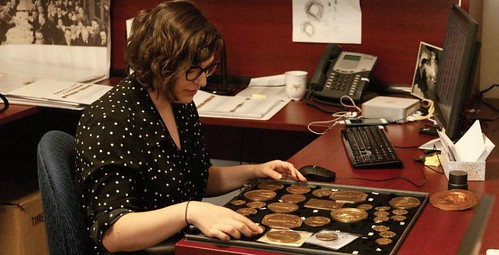
Medallic Art Company Collection Manager Taylor Hartley
This is indeed great news - perhaps news of the century. The company's vast trove of dies, galvanos, medals and archives are now in strong hands, and the history they encompass will be documented and preserved. And while it is unfortunate that the Society will likely be unable to permanently accession all of the material once documentation and evaluation are complete, that is understandable and inevitable due to the massive volume of material. But if and when any surplus items appear on the market it will represent a once-in-a-lifetime opportunity for today's collectors and dealers, and I believe it will lead to a new golden age of collecting not only medals but also the rare and important artwork and artifacts used in their creation.
The hobby is greatly indebted to the ANS Board of Trustees, staff and the phalanx of consultants and helpers who made this transaction possible. Yet this is only the beginning - much work and discovery lie ahead. -Editor
For more information about the American Numismatic Society, see:
Author and Editor Ken Bressett received the Burnett Anderson Memorial Award for Excellence in Numismatic Writing at last month's American Numismatic Association Philadelphia World's Fair of Money. Here's the ANA's announcement. -Editor
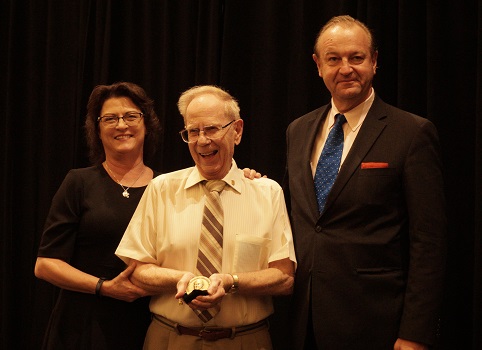
Photo: ANA Executive Director Kim Kiick and Mark Anderson present Bressett (center) with the Burnett Anderson Memorial Award for Excellence in Numismatic Writing.
The achievements of numismatists do not go unnoticed. Each year, the American Numismatic Association (ANA) presents an award to a researcher, author or journalist in recognition of his or her body of work and career contributions to numismatics. Numismatists working to expand interest in coin collecting by recruiting new ANA members also are recognized for their efforts.
During the Philadelphia World’s Fair of Money in August, The Burnett Anderson Memorial Award for Excellence in Numismatic Writing was presented to Kenneth E. Bressett, best known for his dedicated work as editor of A Guide Book of United States Coins (the “Red Book”).
First conferred posthumously in 1999 to its namesake—a newsman’s journalist—the award is sponsored by Krause Publications. The recipient is selected in a cooperative process by the ANA, the American Numismatic Society and the Numismatic Literary Guild.
Bressett, who will celebrate his 90th birthday next month, became active on the Red Book’s editorial staff in 1956, and in 1973 was named editor, effective with the 27th edition. To date, Whitman Publishing has printed more than 24 million copies, making the reliable hobby reference one of the best-selling nonfiction books in American publishing history.
The readily recognizable guide was first edited by R.S. Yeoman, with whom Bressett became acquainted in the mid-’50s. Their long collaboration was cordial and fruitful, and together they created more than 300 hobby-related books and products, including a monthly magazine, Whitman Numismatic Journal (1964-68).
During his 75 years of numismatic involvement, Bressett has focused his efforts on more than United States coins, expanding his knowledge base and books to include ancients, biblical coins, British issues and U.S. paper money, as well as all aspects of grading, buying, selling and collecting. In 1962 he and fellow numismatic scholar Eric P. Newman co-wrote the quintessential Fantastic 1804 Dollar. Among his other notable works as author or editor are Basics of Coin Grading for U.S. Coins; Buying and Selling United States Coins; Collectible American Coins; A Guide Book of English Coins; A Guide Book of Modern United States Currency; A Guide Book of United States Currency; The Handbook of Ancient Greek and Roman Coins; Handbook of United States Coins (the “Blue Book”); Milestone Coins: A Pageant of the World’s Most Significant and Popular Money; Money of the Bible; The Official American Numismatic Association Grading Standards for United States Coins; and The Official Whitman Statehood Quarters Collector’s Handbook.
Writes Bressett in the 72nd (2019) edition of the Red Book, in his new role as editor emeritus, “Throughout the years it has been my privilege to work with many of the leading numismatic dealers and scholars…My involvement has been a richly rewarding experience, for which I will be eternally grateful to my friend Dick Yeoman.”
Says Jeff Garrett, ANA past president and now senior editor of the Red Book, “A Guide Book of United States Coins is the most important numismatic book that has ever been produced. ... It has been the foundation for knowledge of collectors for generations. Most serious collectors and coin dealers have a copy within arm’s reach. Ken Bressett has been the guardian of this important resource for many decades. His dedication to accuracy and his unwavering integrity are the foundation of the book’s long success.”
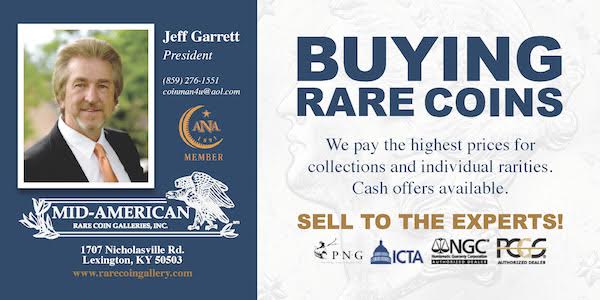
Last week Jeff Garrett published a nice article on the NGC site about how digital photography affected the numismatic hobby. Here's an excerpt - be sure to read the complete version online. -Editor
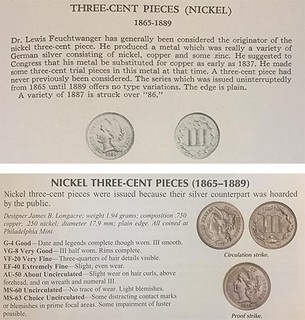 Coin photography has advanced by leaps
and bounds in recent years. Some may be interested in a short history of the subject.
Coin photography has advanced by leaps
and bounds in recent years. Some may be interested in a short history of the subject.
The earliest regular auction catalogs for rare coins in the United States began in the 1850s or so. These early catalogs illustrated coins with the use of woodcuts. That process of illustration had been used for centuries in all forms of media, from books to newspapers.
The limitations of this form of illustration are obvious. You get an idea of what the coin type looks like, but no indication of the actual coin’s appearance. Over the years, I have run across the actual woodcuts used for catalogs, and these are quite collectible themselves.
The first United States auction catalog to use actual photographs was the 1868 Cogan sale of the McKenzie collection. Early auction catalogs are highly collectible, and over the next several decades, many extremely important collections were auctioned. These early sales by the likes of Chapman, Elder, Mehl and many others are very useful for researchers when studying pedigrees for important coins.
Several years ago, a German catalog from 1884 sold for $4,700, mostly because the catalog was the first to feature a photograph of an 1804 Silver Dollar (actually a photo of a plaster cast; the actual coins were deemed too shiny to photograph). Many of these early catalogs are quite interesting to examine because of the staggering size of collections assembled in the early years of organized numismatics.
The quality of photographs in these early catalogs varied extensively. A recent auction catalog by Kolbe and Fanning, offering an example of the 1911 Thomas Elder auction of the William Woodin collection, states “extremely rare, with remarkable photographic plates painstakingly executed by the multi-talented Edgar Adams, one of the most prolific American numismatic researchers and photographers of the early twentieth century.” The catalog sold for $2,937.
The Chapman Brothers were also well known for the quality of photographic plates used in their catalogs.
From 1868 until around the 1970s, most auction catalogs used the same standard black-and-white illustrations. The quality of images varied greatly from company to company.
The recent incredible advances in cameras in our smartphones has been a boom for dealer productivity, as well. I can locate a rare coin on the bourse floor, shoot an incredible image, and text that image to a client in seconds. These tools are also being used with great efficiency on numismatic social media sites. The ease of use, low cost and quality, has leveled the playing field for professional numismatics. A lot of rare coin business is being done around the world because of this new technology.
Even with the many tools available, digital photography and editing is an art. For anyone interested in learning the craft of digital photography, you should consider attending the ANA Summer Seminar. Tom Mulvaney and a few others teach classes each summer in Colorado Springs. The weeklong classes teach the basics of digital photography and editing. The classes are very popular, and most students rave about how much they learn in a short time.
Collectors or dealers who want amazing coin photographs, but lack the necessary skills, should consider the imaging services of NGC. Their Photo Proof and Photo Vision imaging are among the best in the business.
To read the complete article, see:
Here's a selection of interesting or unusual items I came across in the marketplace this week. Tell us what you think of some of these. -Editor
Medusa Head Silver Denarius
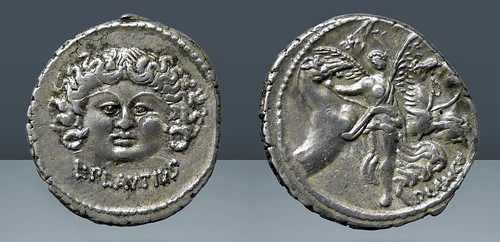
The coinage of the moneyer L. Plautius Plancus is fascinating and has elicited several theories on why he chose the imagery he did. On the obverse of the coin is a mask of Medusa, a beauty turned into a gorgon by the enraged Athena when she broke a vow and married Poseidon instead of remaining celibate her entire life. The reverse shows a winged Aurora, goddess of dawn, holding the reins of four horses before her brother, the Sun.
From the stock of Shanna Schmidt - coin of the week from her September 28, 2018 email newsletter. -Editor
To read the complete item description, see:
1862 50¢ Western & Atlantic Rail Road Note
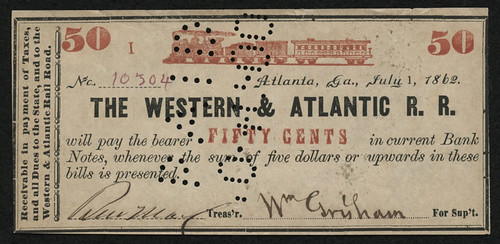
1862 50¢ Fifty Cents - The Western & Atlantic Rail Road
U.S. Civil War scrip is a fascinating area - I collected many of these notes over the years. Nice perforated cancellation on this one. -Editor
To read the complete lot description, see:
Squirrel Design Copper Galvano
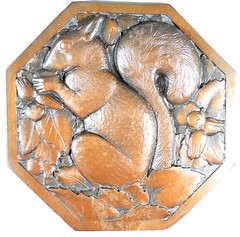
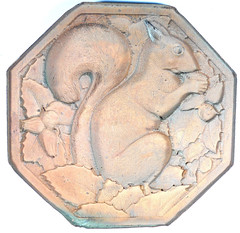
France SQUIRREL Unsigned copper galvano 142mm x 141mm by Thenot
Nice artwork. Is there a medal with this design? Squirrels are cute and furry. Plus, they're not cats. -Editor
To read the complete lot description, see:
Jersey Five Reichmark Token

Jersey German Occupation 5 Reich Mark token.
I don't believe I've ever seen one of these before. Can anyone fill us in on the history? -Editor
To read the complete lot description, see:
0af8d24542e81eb9357e7ef448a6646f/antiques-interiors-and-collectables-auction-lot-33/)
1978 Zodiac Calendar Medal
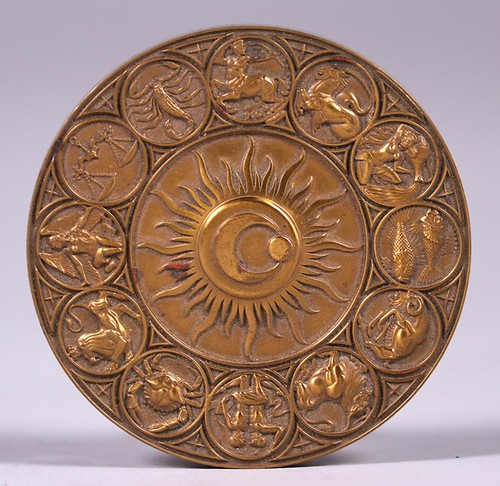
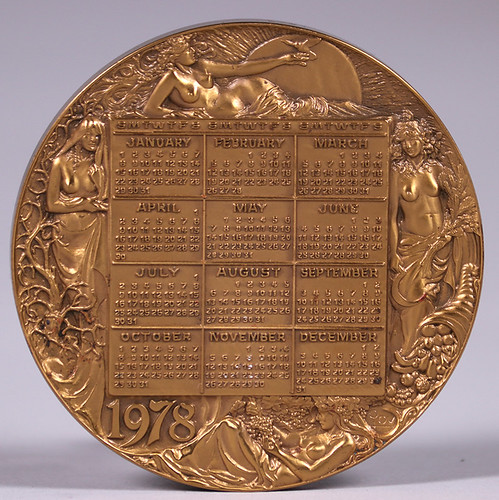
Description: Medallic Art Co - Danbury, CT Zodiac bronze calendar paperweight dated 1977. Signed on edge. Excellent condition. 3"d.
I don't usually include images this large, but for this piece, why not? It's very elaborate - quite detailed and high relief. Very nice. QUICK QUIZ: who can tell us the artist's name? Click on the link or the image to see even larger versions of the image. -Editor
To read the complete lot description, see:
In his September 21, 2018 Stack's Bowers blog, Dave Bowers describes the firm's upcoming sale of the Caine Collection of Federal Proofs and Essays. What a great opportunity to acquire some great rarities. -Editor
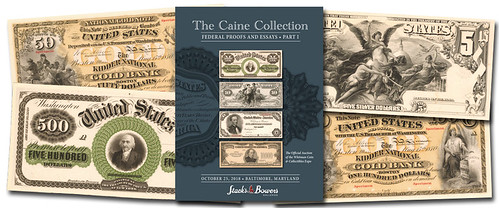
Welcome to Part 1 of the Caine Collection of federal currency proof notes, an unprecedented offering. Such proofs, also called essays, represent the evolution of designs that in most instances were used in this form or modified to create regular series, from those of 1861 onward in the large-size series, continuing into the post-1928 small size.
The proofs range from full face and reverse impressions in full color, some with 000000 serial numbers, to design elements such as portraits and counters.
In the world of collecting paper money, proofs are the rarest of the rare. Even the most available proof issue in the Caine Collection is a rarity in an absolute sense. Many are absolutely unique and others are one of just two or three known.
In their time, proofs were mostly used internally within the Treasury Department currency office in the Treasury Building in Washington, later in the separate Bureau of Engraving and Printing facility. An exception to the internal-use rule was made in 1862 when Secretary of the Treasury Salmon P. Chase sent a large number of proofs to Alexandre Vattemare in Paris, the details of which are related in the story of Vattemare given in the present catalog.
Other proofs passed to the engravers and artists, to Treasury officials, and others whose families eventually placed them into the hands of numismatists. In our recent August sale of Part II of the Joel R. Anderson Collection we showcased a regular-issue $50 “Technicolor” Gold Certificate that had been given to President Theodore Roosevelt. In the sister field of stamp collecting, the personal collection of President Franklin D. Roosevelt, including stamps made to his order, were sold on the open market. The provenances of most proof notes were never recorded, and thus much fascinating information has been lost. We do have, however, many auction and other sale records from recent decades.
Among the highlights of proofs in the Caine Collection are full plate impressions as well as design elements from the famous “Educational Note” series of the 1890s, most famously from 1896, but with some proofs bearing other dates from 1891 to 1897. Many of these came from the remarkable collection of Harry W. Bass, Jr. that we cataloged and sold in 2011, never thinking that we would handle these treasures again.
In creating this listing I worked from an initial file created by Matt Quinn, in many instances taking from some of the descriptions we did years ago, such as for the Bass Collection notes. Others were new to Matt and me and involved new research and exploration. I particularly enjoyed writing about Alexandre Vattemare and might even do a book on him someday!
The term “rarest of the rare” is often used in our catalogs, especially when famous coins or rare varieties are offered. Most such coins are expensive, say over the $100,000 line. Not so with the Caine Collection proofs. “Rarest of the rare” applies to many that we estimate in just four figures. Opportunity is also applicable. I never know when a rarity or unique item will pass through our hands again, but many are off the market for generations. Just about any proof in the Caine Collection is sufficiently rare that a decade or generation can pass between offerings. Accordingly, opportunity is at your fingertips now, but may not be in the future.
We are delighted and honored to present the Caine Collection—not even closely approached by any other collection of federal proof notes ever to cross the block.
To read the complete article, see:
Here's the press release for Duane Feisel's upcoming token sale. -Editor
A Mail Bid Sale of exonumia material offered by Duane H. Feisel is scheduled with advance bid closing on Saturday, October 27. “Bid Bumping” will be open on Sunday, October 28, for advance bids of $50 and greater. This sale offers a wide variety of material with special sections for Illinois, Canada, transportation, and Brunswick-Balke-Collender style tokens. The wide-ranging general section includes tokens for saloon, brothel/bawdy/ladies, a number of states including Arizona, California, Colorado, Michigan, Minnesota, Missouri, Montana, Nebraska, Nevada, Oklahoma, and others. There are also foreign tokens, military tokens, and a number of interesting medals.
The catalogue listing for this Mail Bid Sale has been published by the National Token Collectors Association (NTCA) in the October issue of their monthly publication, Talkin’ Tokens. The listing can also be obtained with an email request to
collector.ca@frontier.com. Many of the items being offered can be viewed at the photo hosting website https://tinyurl.com/yacjprmo .Here is a selection of items being offered in this Mail Bid Sale:
Indian Territory Grady Trading Co.
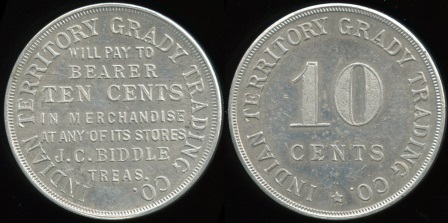
INDIAN TERRITORY GRADY TRADING CO. / WILL PAY TO / BEARER / TEN CENTS / IN MERCHANDISE / AT ANY OF ITS STORES / J.C. BIDDLE / TREAS. // Indian Territory Grady Trading Co. / 10 / Cents. (Hartshorne IT).
Good For Entrance to Paradise Token
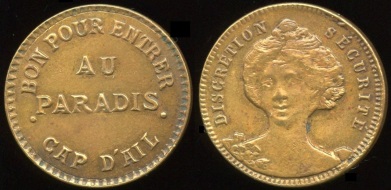
BON POUR ENTRER / AU / PARIDIS / CAP D’AIL // Discretion Securite / (head of woman facing), (France). Good For Entrance to Paradise!
Hudson's Bay Company Token
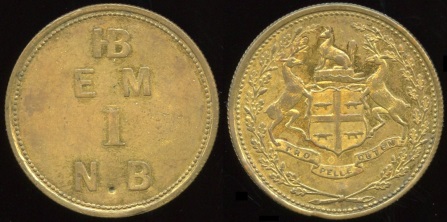
HB / E M / 1 / N (punchmark: .) B // (crest of the Hudson's Bay Company), reeded edge.
Cheyenne Agency Token
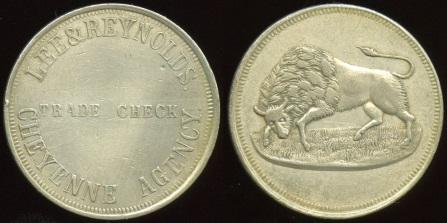
LEE & REYNOLDS. / TRADE CHECK / CHEYENNE AGENCY. // (charging buffalo), (OT).
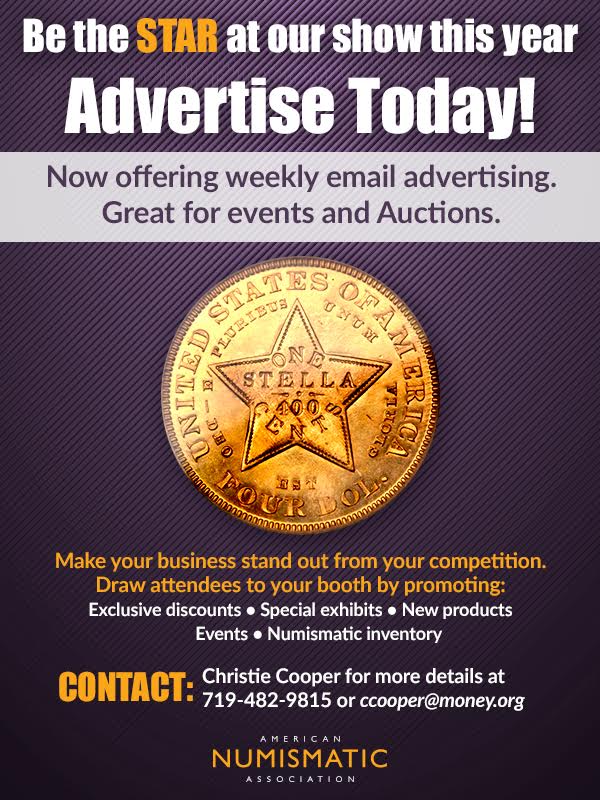
Archaeology magazine published a story about an effort to map and analyze patterns of medieval artifacts, including coins, found in nordic Christian churches. Here are some excerpts. -Editor
More than 100,000 coins, as well as an assortment of other objects, have been found beneath the wooden floorboards of medieval Christian churches in Norway, Sweden, and Denmark. Science Nordic reports that Svein Harald Gullbekk of the University of Oslo and his team looked for patterns in the medieval artifacts, which he thinks were dropped from people’s pockets during services in Sweden’s Bunge Church. “When we investigated where hairpins, pearls, and other objects associated with women were found in Bunge Church in Gotland, we found that more than 95 percent of them were on the north side of the nave,” he said. This corresponds with the historic practice of segregating men and women within the building, placing women to the north.
To read the complete article, see:
The article includes information on the medieval economy, trade and coin-making. -Editor
For the Gotland Vikings, accumulation of wealth in the form of silver coins was clearly a priority, but they weren’t interested in just any coins. They were unusually sensitive to the quality of imported silver and appear to have taken steps to gauge its purity. Until the mid-tenth century, almost all the coins found on Gotland came from the Arab world and were around 95 percent pure. According to Stockholm University numismatist Kenneth Jonsson, beginning around 955, these Arab coins were increasingly cut with copper, probably due to reduced silver production. Gotlanders stopped importing them. Near the end of the tenth century, when silver mining in Germany took off, Gotlanders began to trade and import high-quality German coins. Around 1055, coins from Frisia in northern Germany became debased, and Gotlanders halted imports of all German coins. At this juncture, ingots from the East became the island’s primary source of silver.
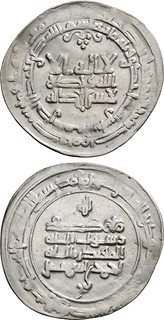 Interestingly, when a silver source from
the Arab or German world slipped in quality, Jonsson points out, and the Gotlanders rapidly cut off the debased supplies, their contemporaries on mainland Sweden and in areas of
Eastern Europe did not. “Word must have spread around the island, saying, ‘Don’t use these German coins anymore!’” says Jonsson. To test imported silver, Gotlanders would shave a
bit of the metal with a knife so its contents could be assessed based on color and consistency, says Ny Björn Gustafsson of the Swedish National Heritage Board. He notes that many
imported silver items found on Gotland were “pecked” in this way, and that Gotlanders may also have tested imported coins by bending them. By contrast, silver items thought to
have been made on Gotland—including heavy arm rings with a zigzag pattern pressed into them—were not generally pecked or otherwise tested. “My interpretation,” Gustafsson says,
“is that this jewelry acted as a traditional form of currency and was assumed to contain pure silver.”
Interestingly, when a silver source from
the Arab or German world slipped in quality, Jonsson points out, and the Gotlanders rapidly cut off the debased supplies, their contemporaries on mainland Sweden and in areas of
Eastern Europe did not. “Word must have spread around the island, saying, ‘Don’t use these German coins anymore!’” says Jonsson. To test imported silver, Gotlanders would shave a
bit of the metal with a knife so its contents could be assessed based on color and consistency, says Ny Björn Gustafsson of the Swedish National Heritage Board. He notes that many
imported silver items found on Gotland were “pecked” in this way, and that Gotlanders may also have tested imported coins by bending them. By contrast, silver items thought to
have been made on Gotland—including heavy arm rings with a zigzag pattern pressed into them—were not generally pecked or otherwise tested. “My interpretation,” Gustafsson says,
“is that this jewelry acted as a traditional form of currency and was assumed to contain pure silver.”
Researchers found that the metalworkers of Fröjel used an apparatus called a cupellation hearth to transform a suspect source of imported silver, such as coins or ingots, into jewelry or decorated weapons with precisely calibrated silver content. They would melt the silver source with lead and blow air over the molten mélange with a bellows, causing the lead and other impurities to oxidize, separate from the silver, and attach to the hearth lining. The resulting pure silver would then be combined with other metals to produce a desired alloy. The cupellation technique is known from classical times, says Gustafsson, but so far this is the first and only time such a hearth has been found on Gotland.

An example of one of the earliest silver coins minted on Gotland
Archaeologists have found that, throughout the ninth and tenth centuries, silver hoards were distributed throughout Gotland, suggesting that wealth was more or less uniformly shared among the island’s farmers. But around 1050, this pattern shifted. “In the late eleventh century, you start to have fewer hoards overall, but, instead, there are some really massive hoards, usually found along the coast, containing many, many thousands of coins,” says Jonsson. This suggests that trading was increasingly controlled by a small number of coastal merchants.
This stratification accelerated near the end of the Viking Age, around 1140, when Gotland began to mint its own coins, becoming the first authority in the eastern Baltic region to do so. “Gotlandic coins were used on mainland Sweden and in the Baltic countries,” says Majvor Östergren, an archaeologist who has studied the island’s silver hoards. Whereas Gotlanders had valued foreign coins based on their weight alone, these coins, though hastily hammered out into an irregular shape, had a generally accepted value. More than eight million of these early Gotlandic coins are estimated to have been minted between 1140 and 1220, and more than 22,000 have been found, including 11,000 on Gotland alone.
Gotland remained a wealthy island in the medieval period that followed the Viking Age, but, says Carlsson, “Gotlanders stopped putting their silver in the ground. Instead, they built more than 90 stone churches during the twelfth and thirteenth centuries.” Although many archaeologists believe that the Gotland Vikings stashed their wealth in hoards for safekeeping, Carlsson thinks that, just as did the churches that were built later, they served a devotional purpose. In many cases, he argues, hoards do not appear to have been buried in houses but rather atop graves, roads, or borderlands. Indeed, some were barely buried at all because, he argues, others in the community knew not to touch them. “These hoards were not meant to be taken up,” he says, “because they were meant as a sort of sacrifice to the gods, to ensure a good harvest, good fortune, or a safer life.” In light of the scale, sophistication, and success of the Gotland Vikings’ activities, these ritual depositions may have seemed to them a small price to pay.
To read the complete article, see:
Hoards of the Vikings (page 5) (https://www.archaeology.org/issues/240-1701/features/5123-sweden-gotland-viking-wealth#art_page5) THE SHILLINGS OF ELIZABETH I
Dealer Allan Davisson, in an email to clients earlier today included a short article on Elizabeth I shillings, a number of examples of which appear in his firm's E-Auction 27, closing October 17, 2018. With permission we're republishing the article here. Thanks! -Editor
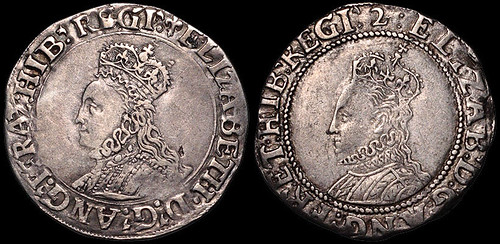
The first and last Elizabeth I Shillings
Shillings were a Tudor innovation that began with the coinage reform under Edward VI. The reign of Elizabeth saw the denomination expand in scope and complexity to meet the ongoing challenges of coinage for local economies and expanding international commerce. Over a reign of forty-five years, multiple styles, varying silver content and evolving technologies continued the coinage reform that began during the reign of Edward VI.
It is too casual an assumption to think the “fine issue” coinage of 1551 solved the problem of debased coinage and the effective fraud it brought to commerce. During the early years of Elizabeth’s reign, debased coinage was still circulating and was still needed in the marketplace. Countermark centers were established, with local “wise men” given greyhound or portcullis punches to be used to value circulating pieces. Discriminating value required the ability to identify portrait styles, something you can readily review in the current Standard Catalog.
Finally, by September 1561, the debased coinage was demonetized and the recoinage was completed. (This was the era of Thomas Gresham who gave us a law that still applies.)* The first fine silver of 1559-60 with the lis as the initial mark was the beginning of this new establishment of a reliable currency. By the end of her reign there were seven issues, six major hammered bust types with many variations, a milled coinage and even a couple of pattern issues that were never used for circulating coinage.
The strength of the currency that she left behind reflected an amazing woman who navigated court intrigues, international threats, and even her own tendency toward uncertainty at times about decisions she had to make. At the end of her reign England was a major power. Coinage was stable and reliable and the engravers and mintmasters had established a new level of artistic merit to their productions.
This sale features four markedly different shillings of Elizabeth I: a choice and scarce first issue first bust piece, a more worn second bust example of the first issue, an attractive—though marked in the field and priced accordingly—second issue piece, and finally the rare “2” initial mark last piece of her reign.
A final observation: After handling many Elizabeth shillings and sixpences over the years, I have noticed how often these pieces are “well used.” They were issued in an era that began with coinage scarcity. They were used in an era where commerce was active and growing. They portrayed an amazing and widely popular ruler and were probably often saved as pocket pieces or mementoes in less than optimal storage. It is notably easier to find high quality shillings of Edward VI, James I and Charles I than it is of Elizabeth. (Philip and Mary? A limited coinage and an unrealized plan for silver coinage restoration… A story for another time.)
*”Bad money drives out good.”
To browse the Davisson's E-Acution 27, see:
David Sundman passed along this article from The Times about a shipwreck carrying cowrie shell money. -Editor
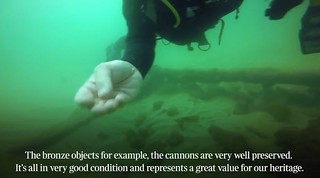 The wreck of a 400-year-old ship
carrying seashells, porcelain and spices, and armed with cannons, has been found off the coast of Portugal in what archaeologists have called the discovery of the decade.
The wreck of a 400-year-old ship
carrying seashells, porcelain and spices, and armed with cannons, has been found off the coast of Portugal in what archaeologists have called the discovery of the decade.
The remains of the vessel, which divers found in about 12 metres (40ft) of water, include nine bronze cannons engraved with the Portuguese coat of arms, Chinese ceramics, condiments and cowrie shells, which were used as currency among slave traders.
“From a heritage perspective, this is the discovery of a decade,” said Jorge Freire, scientific director of the team. He said the wreck, which was found in the mouth of the River Tagus close to Cascais, near Lisbon, and is believed to date from between 1575 and 1625, when Portugal’s spice trade with India was at its peak. Artefacts have been removed from the site to help scholars identify the name of the ship and where it had sailed from.
To read the complete article, see:
Here's an interesting piece offered in next month's Stack's Bowers sale at the Whitman Coin & Collectibles Baltimore Expo. James McCartney wrote about it in his September 21, 2018 blog. -Editor
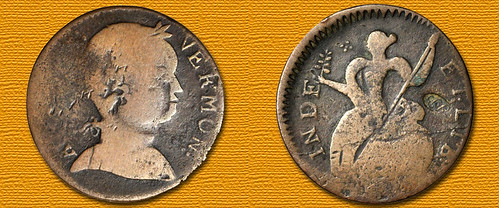
One of the most significant offerings in our October 2018 Baltimore Auction is a 1786 Ryder-9 Vermont copper countermarked in a manner most familiar to collectors of Regulated gold. This piece is a delightful representative of the popular Baby Head variety, offering glossy surfaces and bold definition to each side. The reverse is rotated 90 degrees clockwise, orienting AUCTORI opposite the date and leaving both soft. Darker coffee and russet patina inhabits the fields, while the devices show lighter honey-brown coloration. Slightly drawn towards 5 o'clock on the reverse, which just trims the tops of LIB at the edge. The planchet shows a narrow and natural flaw that spans from the rim near I of LIB to the I of INDE.
Most significant is an elliptical countermark in the right reverse field enclosing the characters JB written in cursive. What appears to be a small "o" separates the two larger letters. This mark is likely the work of English silversmith John Bailey, who was working throughout New York state from the 1750s up until his death in 1815. This mark is inverted relative to the reverse motif, and is precariously placed between the hip of the seated figure and the colon separating ET LIB. The oval cartouche is tight to the letters within, and the punch is deeply impressed at the right but more shallow at the left. Considerable patina fills the crevices of the mark, though the identification as the letters JB is unmistakable. Though we have not found a completely identical match to the present mark, we are led to the attribution of Bailey through both contextual evidence and stylistic similarities to his signature on his swords and similar oval punches found on cutlery from the Fishkill area.
While the current JB countermark has not been previously tied to numismatics, John Bailey himself is certainly a familiar figure within the context of early U.S. coinage. Upon his return to New York City in 1784 after the war, Bailey formed a coalition with goldsmith Ephraim Brasher to petition the New York State legislature to secure a coinage contract. In demonstration of their capabilities, they issued several "pattern" coppers including the 1787 Excelsior copper and 1787 Nova Eborac copper which are popular among colonial collectors today.
Bailey is also considered responsible for the Running Fox varieties of the New Jersey copper, which share punches with the Excelsior coppers, Nova Eborac coppers, and even the famous 1787 New York Brasher doubloons. With a modern weight of under 98 grains it was considerably lighter than most recognized issues of the era, though the mark of a respected silversmith was likely enough to assuage suspicion. This specimen is a potentially crucial piece in the fascinating and complex puzzle of the early American economy and it is sure to draw considerable interest from collectors of many specialties.
To read the complete article, see:
The Künker auction house published this press release about the donation of a medal collection to the Leipzig University Library. -Editor
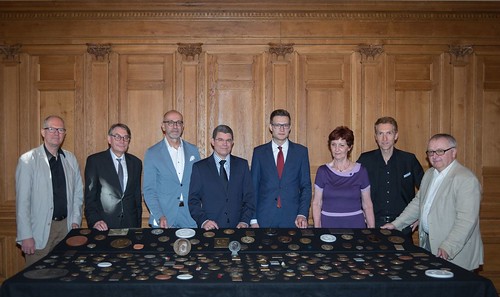
Leipzig University Library receives collection of medals made by the local artist Bruno Eyermann
On 19 September 2018, the Leipzig University Library first presented its 218 newly-acquired collection of medals made by Bruno Eyermann (1888-1961) to the public. Eyermann was the central figure among Leipzig’s artistic medalists in the first half of the 20th century. Thanks to generous third-party funds, the library was able to purchase the extensive collection.
The newly-acquired Eyermann medal collection is of unique size and quality. The 218 medals represent over 80 percent of the known Eyermann oeuvre and cover all of his creative periods with items of especially high quality. Over decades, the collection had been compiled by the Leipzig graphic artist and numismatist Klaus Thieme who passed away in 2013. It was his wish that the Eyermann collection remain intact and be made available to a public institution for further use. Dr. Christoph Mackert, curator of the coin collection and director of the manuscript collection at the Leipzig University Library, points out: “It is a pleasure that the medals now join the inventory that he helped build with such commitment and in which a significant void can now be filled.”
After his studies at the Leipzig Academy of Fine Arts, Bruno Eyermann started working there as a lecturer in 1919. In 1923, he started a rich production of medals as an independent artist, characterized by its exceptionally firm and realistic graphic style, which, with its orientation towards Classical Modernism and New Objectivity, went on to significantly influence even the German Democratic Republic’s medal art. Another typical feature is his experiment with different formats and materials. Eyermann seems to have always avoided coming too close to the different political systems he experienced.
Starting in October, the collection will be publicly presented as part of a new exhibition at the library: “GELDKULTURERBE. 300 Jahre Münzsammlung der UB Leipzig” on occasion of the 300th anniversary of the library’s coin collection, from 5 October 2018 until 1 January 2019. A catalog of the same name will be published at the exhibition’s opening on 4 October.
It was the collaboration of several sponsors that enabled the library to purchase the collection: the Kulturstiftung der Länder [Cultural Foundation of the German Federal States], the Ostdeutsche Sparkassenstiftung [East-German Savings Bank Foundation] together with the Sparkasse Leipzig, the Fritz RudolfKünkerGmbH & Co. KG Osnabrück as well as the Verband der Deutschen Münzenhändler e. V. [Association of German Coin Dealers]. On occasion of the 300-year anniversary of the coin collection in 2018, they not only gave the Leipzig University Library an amazing birthday gift, but also set an important basis for future scientific work on Leipzig’s artistic medals.
“Our task of cultural promotion in the 16 German federal states is fulfilled in the best way when we are able to secure locally-embedded cultural assets of national importance for the public”, emphasizes Prof. Dr. Frank Druffner, Deputy Secretary-General of the Kulturstiftung der Länder. “The collection that was so knowledgeably compiled by Klaus Thieme is a representation of design history from the late German Empire across the Weimar Republic and National Socialism up to the two German post-war states.”
“The Ostdeutsche Sparkassenstiftung and the Sparkasse Leipzig have been partners of the University of Leipzig for years. We are happy to be able to help once again and sponsor the Eyermann collection’s purchase. Leipzig and its university library are gaining a treasure. Handicraft, art and history are wonderfully combined in this. We are looking forward to the exhibition starting in October. Our tip: Make sure to visit, look at the exhibits and let yourselves be amazed”, Andreas Koch from Sparkasse Leipzig and Alexander Salomon from the Ostdeutsche Sparkassenstiftung said at the presentation.
Ulrich Künker, managing director of the Fritz RudolfKünkerGmbH & Co. KG is happy that the auction house was able to lay the foundation for the purchase: “We agree with the collector that this exceptional and extensive collection should be presented to the public in its entirety. We at the auction house and coin dealershipKünkerconsider it both our pleasure and our task to preserve this collection of almost all Eyermann works for research as well as for the public.”
Here's one example of a Bruno Eyermann I located online. -Editor
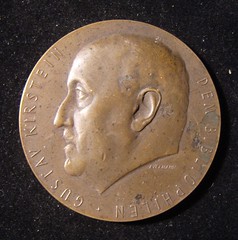
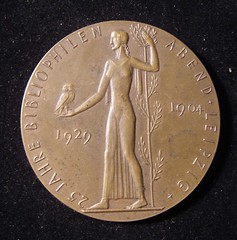
1929 Gustav Kirstein Medal
Art Daily's Photos of the Day for Monday, September 24, 2018 were taken at an exhibit of a new bank branch in Stockholm. -Editor
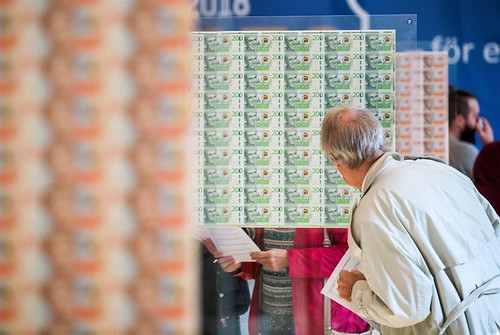
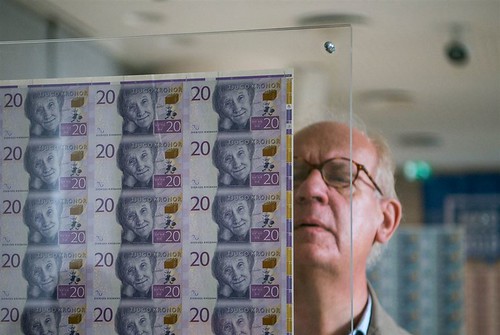
People visit an exhibition containing private banknotes, Sweden's first coin and a copy of the world's largest copper coin on September 22, 2018 in Stockholm during an open day at the head office of the Riksbank, Sweden's Central Bank, to mark the 350th anniversary of its creation. On September 22, 1668, the Bank of the Estates of the Realm was founded, which later changed its name to Sveriges Riksbank. Exactly 350 years after the bank was founded, the Riksbank holds an open day at Brunkebergstorg in Stockholm.
To read the complete article, see:
This article from Quartz posits a future where banknotes and digital funds coexist. Interesting idea. -Editor
 Imagine that all banknotes have a chip in
them. That’s inevitable, anyway: Banks will soon want to make it possible to determine whether a note is valid or not with absolute certainty. Imagine further that the banknote
has some kind of short radio interface through which it can communicate with mobile devices. That’s not far-fetched, either: Many items in the supermarket already do, after all,
in the form of RFID tags. Finally, imagine that the banknote’s appearance changes when the chip is turned off: Its inky color turns to grayscale. Soon these three technologies
will all be printable directly on thin, flat surfaces.
Imagine that all banknotes have a chip in
them. That’s inevitable, anyway: Banks will soon want to make it possible to determine whether a note is valid or not with absolute certainty. Imagine further that the banknote
has some kind of short radio interface through which it can communicate with mobile devices. That’s not far-fetched, either: Many items in the supermarket already do, after all,
in the form of RFID tags. Finally, imagine that the banknote’s appearance changes when the chip is turned off: Its inky color turns to grayscale. Soon these three technologies
will all be printable directly on thin, flat surfaces.
With that setup, you’ll be able to transfer value from your banknote directly to your bank account. You want to deposit a $20 banknote into your account? No need to go to a bank branch or ATM: Just wave the banknote in front of your mobile phone and have the $20 transferred from the banknote to your bank account. Your bank balance increases by $20, the state of the banknote’s chip is changed to “no value,” and the note itself is visibly grayed out.
But that doesn’t mean you should throw the value-depleted banknote away: You might want to use it to withdraw money from your account later. Wave a gray banknote in front of your mobile phone, and transfer $20 back into it from your digital bank account. The state of the note’s chip changes to “valid,” and it recovers its full color. Now it can function as a normal banknote, and everyone will readily see it’s a valid because of its color.
With such a system of smart banknotes, everyone could take the matter of cashing in and out into their own hands. Your phone truly becomes a personal ATM.
This proposal brokers a peace agreement between digital and hard cash; it lets some people keep their money habits if they can’t or don’t want to change, and the rest of us who prefer our money in the cloud can operate totally digitally. Moreover, the specialized logistics, cost, and security risk of cash transport and storage disappears.
To read the complete article, see:
Numismatic bibliophiles love coin books. But how about a really cool STAMP book? This article from Smithsonian magazine discusses a new exhibit showcasing the stamp collection of Beatle John Lennon. -Editor
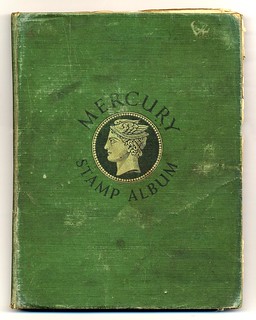
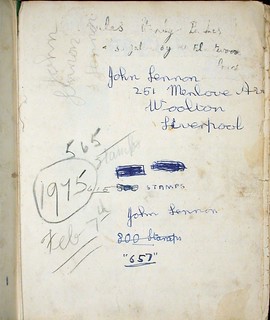
Lennon’s stamp collecting was inspired by his late cousin Stanley Parkes, who gave him the classic Mercury album (with a picture of the god Mercury on the cover) when John was 10 years old. The album’s new owner wrote his name on the title page, after erasing Stanley’s, and beneath it his address at the time: 451 Menlove Ave., Woolton, Liverpool. (The house of his aunt Mimi, later bought by Yoko Ono and given to the National Trust.) As a boy, Lennon prefigured his future of counter culture cheekiness by sketching moustaches and beards on the book’s images of Queen Victoria and King George VI.
The album found its way to the Smithsonian when the curator of the Postal Museum, W. Wilson Hulme, who died in 2007, read an article about it having been bought at auction in London by a rare book dealer. I first wrote about the album when it was displayed in 2005, speculating that most young boys just want to be cool, and stamp collecting might seem embarrassingly uncool. But Hulme told me at the time, “There was nobody cooler than John Lennon.” Amen!
The 150 pages of the Mercury album now contains 565 stamps, though Lennon’s front-page notations, written over his erased cousin’s name, show the number 657 in quotes, and the number 800 crossed out. More mysteries. Was 800 Lennon’s hoped-for goal? Were some of the stamps in the album, perhaps those collected by Parkes, traded away or discarded as not up to young John’s standards.
At some point, the young Lennon pasted his last stamp into his green book, put down the album and picked up a guitar. The rest is musical history, but at the Postal Museum, philately history lives on.
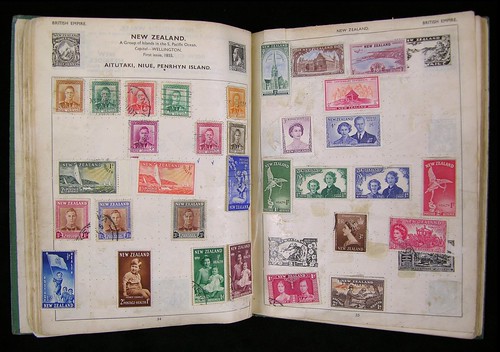
To read the complete article, see:
Here are some additional items I came across in the media this week that may be of interest. -Editor
September 2018 CCAC Coin Design Recommendations
The Treasury Department’s Citizens Coinage Advisory Committee met at U.S. Mint headquarters in Washington, D.C., on Thursday, September 27, 2018. This article summarizes their rcommendations. -Editor
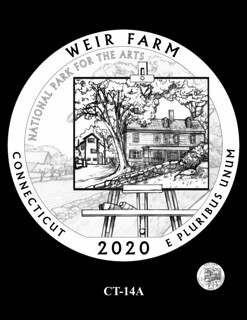

To read the complete article, see:
How Much is That Italian Gold Coin Hoard Worth?
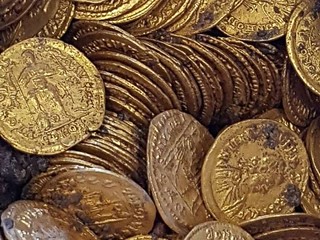 What do archaeologists know about
rare coin valuation? Sometimes they're just guessing. Ursula Kampmann of CoinsWeekly takes a stab at estimating the value of the recent gold coin hoard find in Italy.
-Editor
What do archaeologists know about
rare coin valuation? Sometimes they're just guessing. Ursula Kampmann of CoinsWeekly takes a stab at estimating the value of the recent gold coin hoard find in Italy.
-EditorTo read the complete article, see:
To read the earlier E-Sylum article, see:

